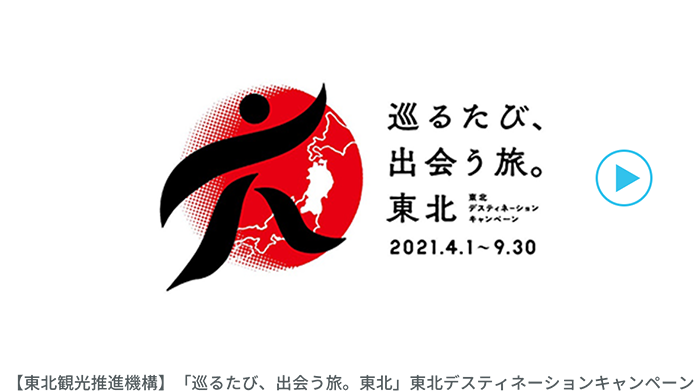Reconstruction in Data
The state of reconstruction, presented in objective numbers.
Overview / Population / Movements in the populations of the three affected prefectures (by age)
- - Youth population and productive age population are declining, relative to nationwide population, in Iwate and Fukushima Prefectures.
- - Movements in Miyagi Prefecture match nationwide movements.
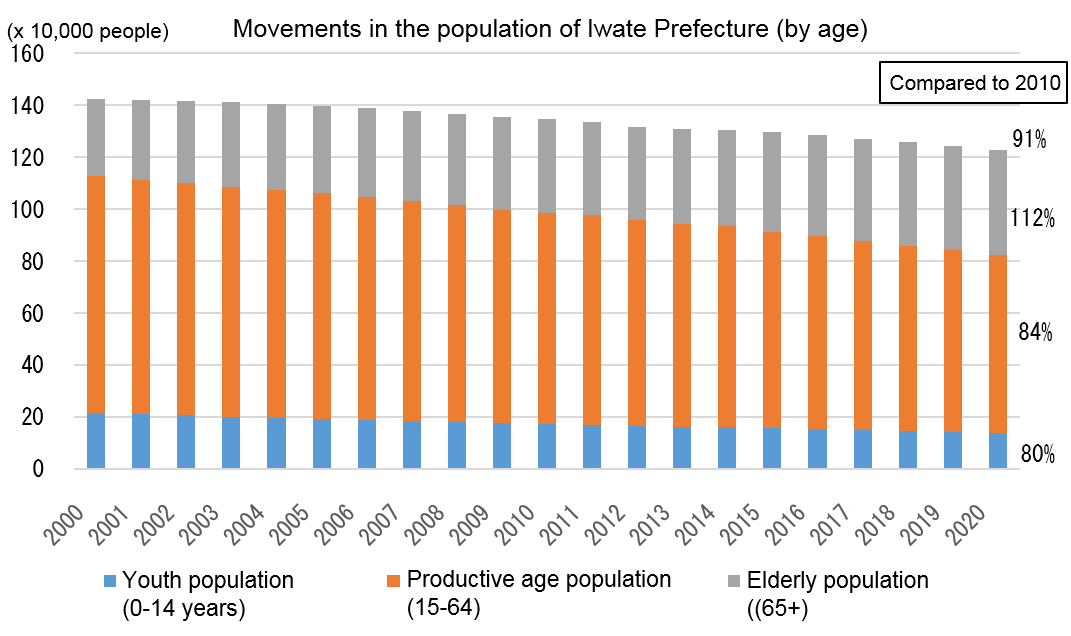
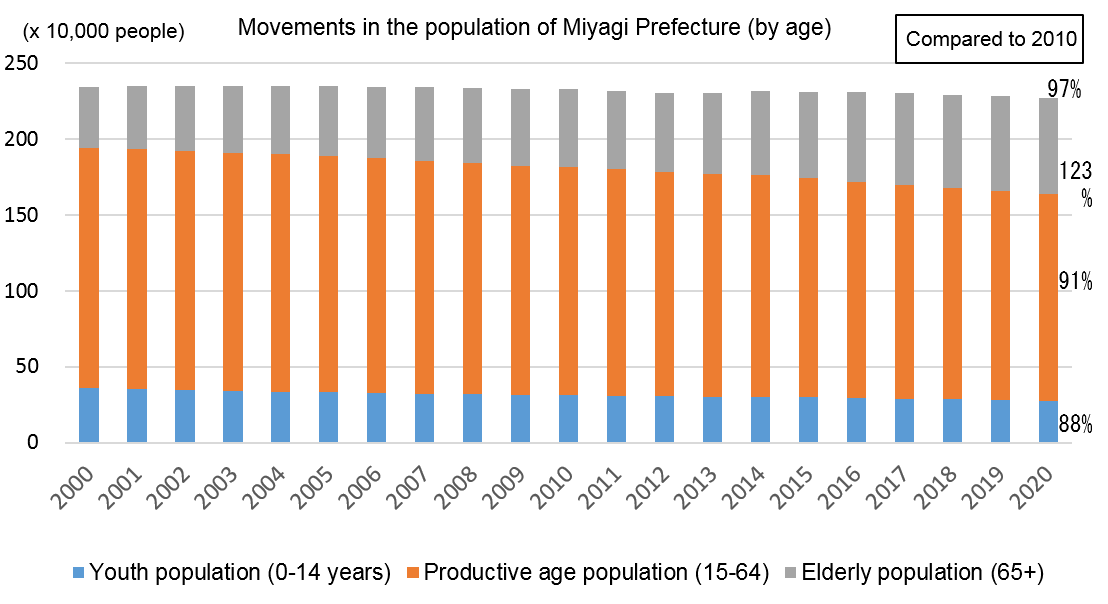
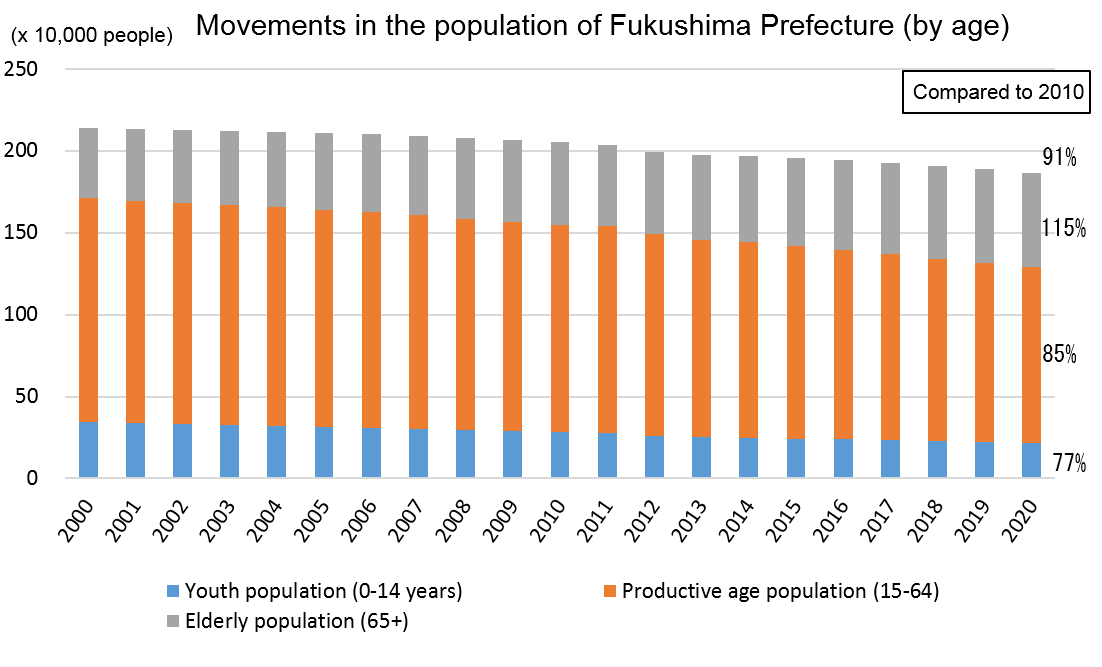
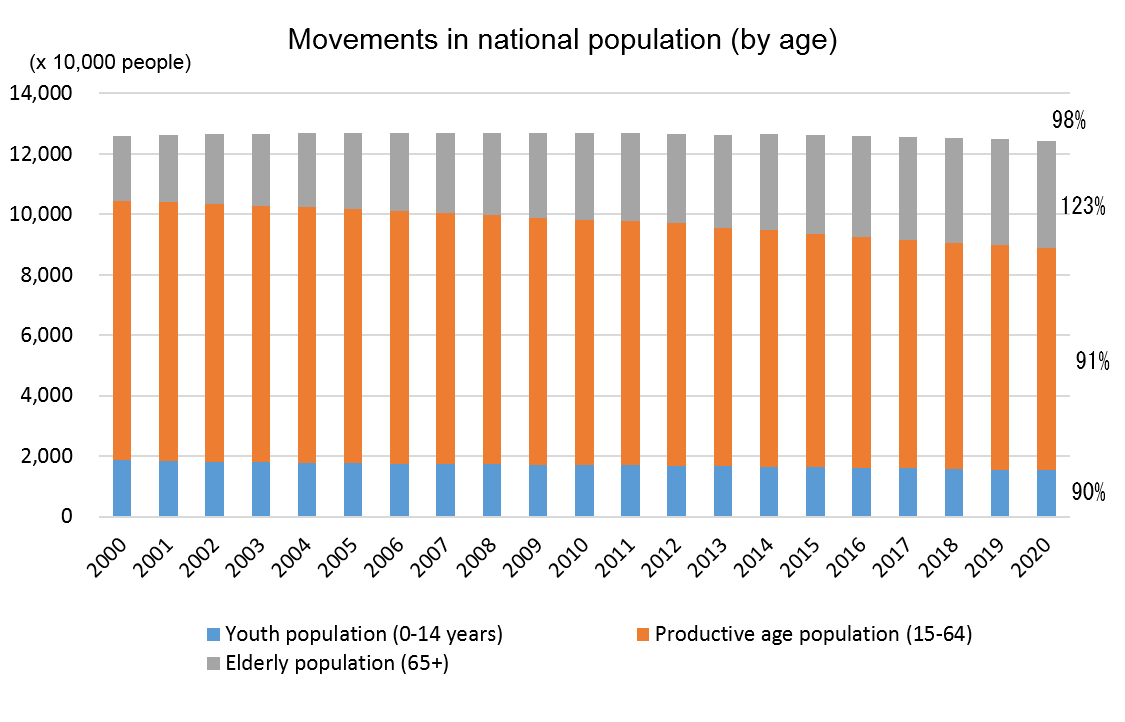
Overview / Population / Movements in population change in the three affected prefectures (by natural and social change)
- - In 2012, immediately after the disaster, all three affected prefectures suffered major natural and social population declines.
- - After that, natural and social declines continued in Iwate and Fukushima Prefectures, but social decline in Miyagi Prefecture diminished.
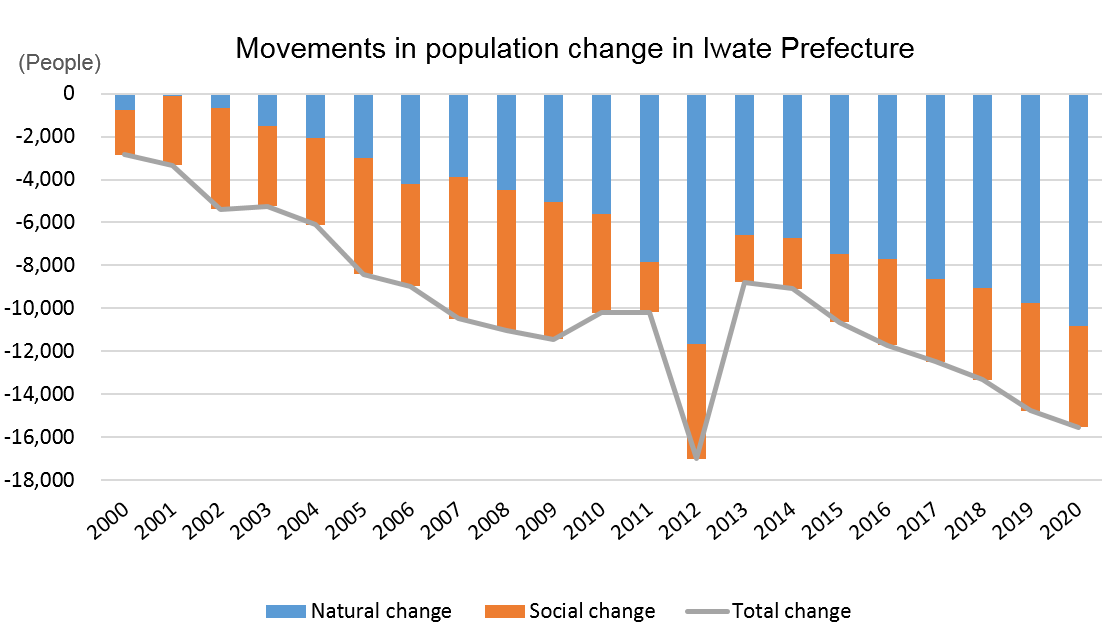
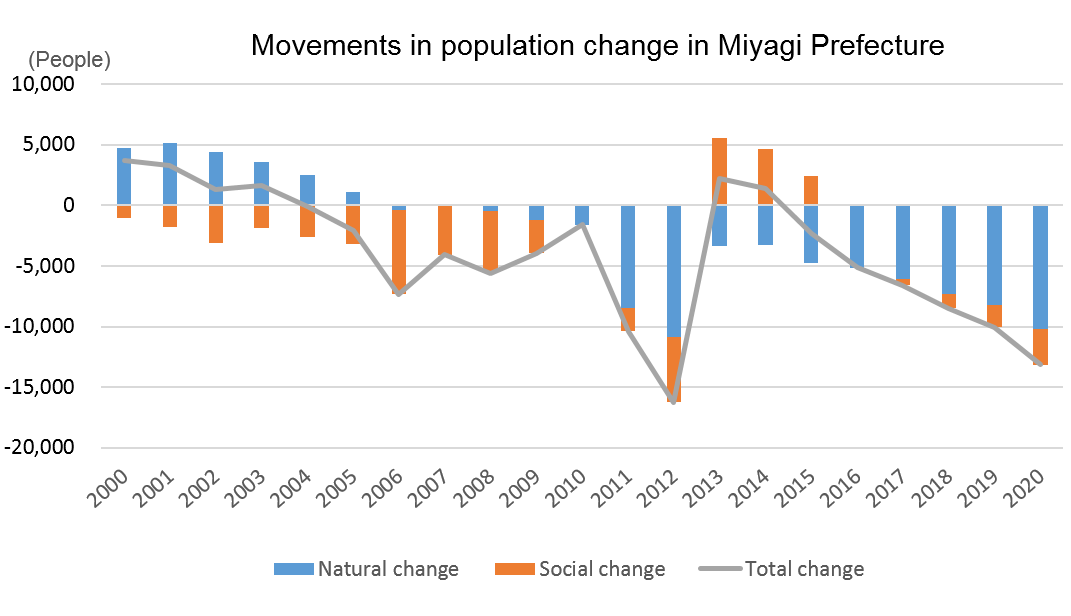
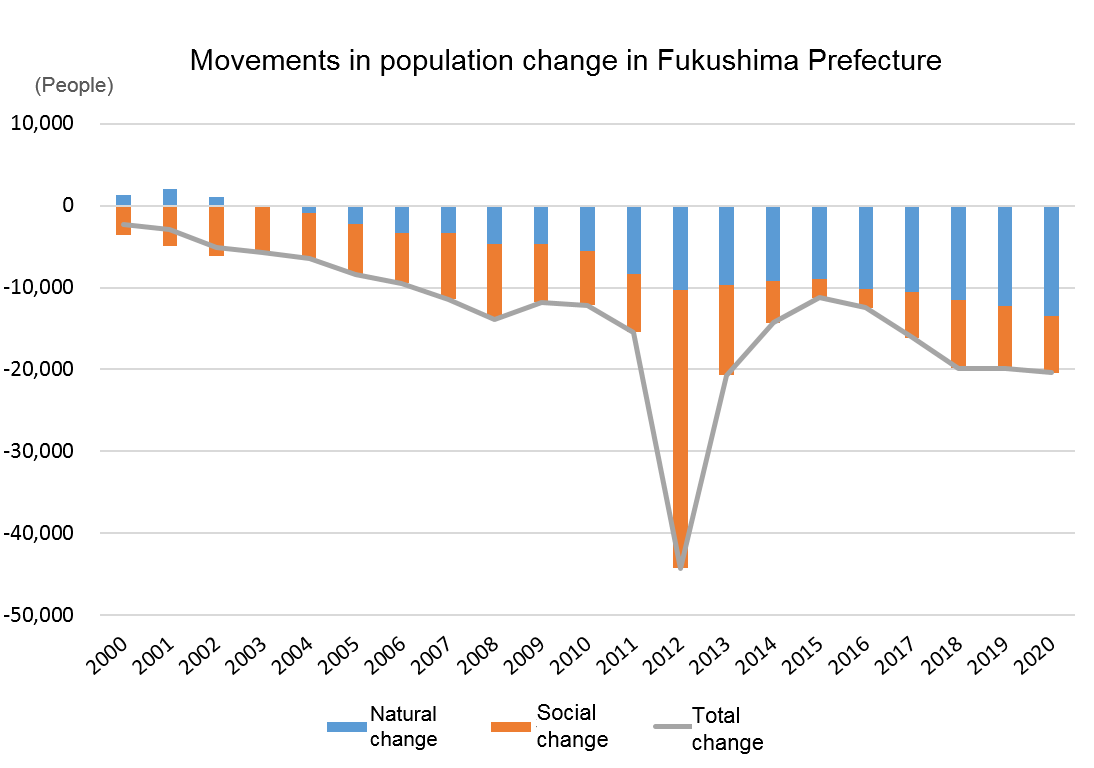
Overview / Population / Rates of population change in coastal areas of Iwate Prefecture and Miyagi Prefecture (2020/2010)
- - In the coastal areas of the three affected prefectures in particular, population decline has been ongoing since the disaster (excluding Sendai and its environs).
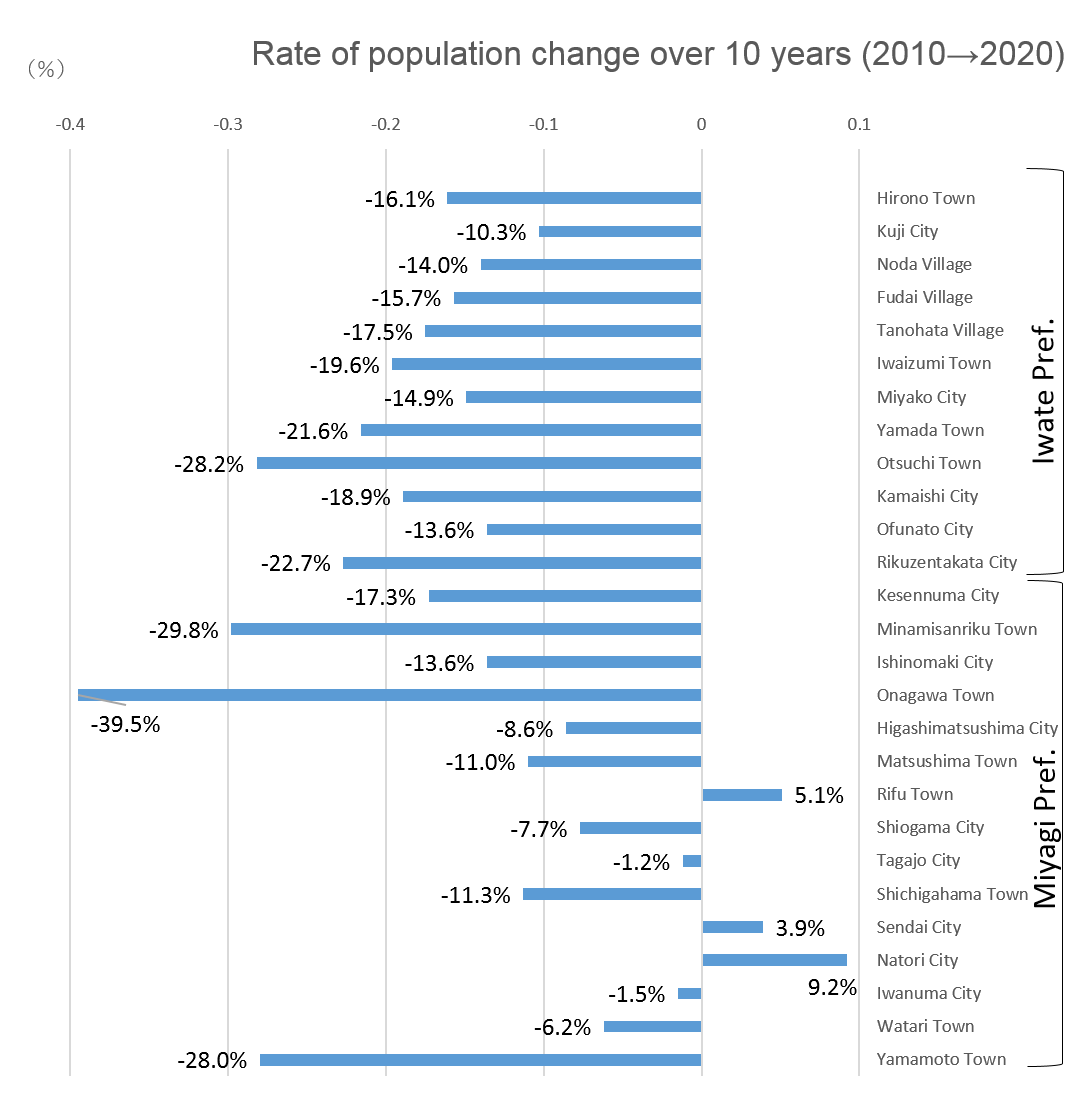
Source: Ministry of Internal Affairs and Communications, "Survey of population, population dynamics, and numbers of households, based on basic resident registration", Japanese residents
Support for sufferers / Numbers of evacuees / Movements in the three affected prefectures
- - The number of evacuees dropped from a peak of 470,000 to 42,000 (January 2021).
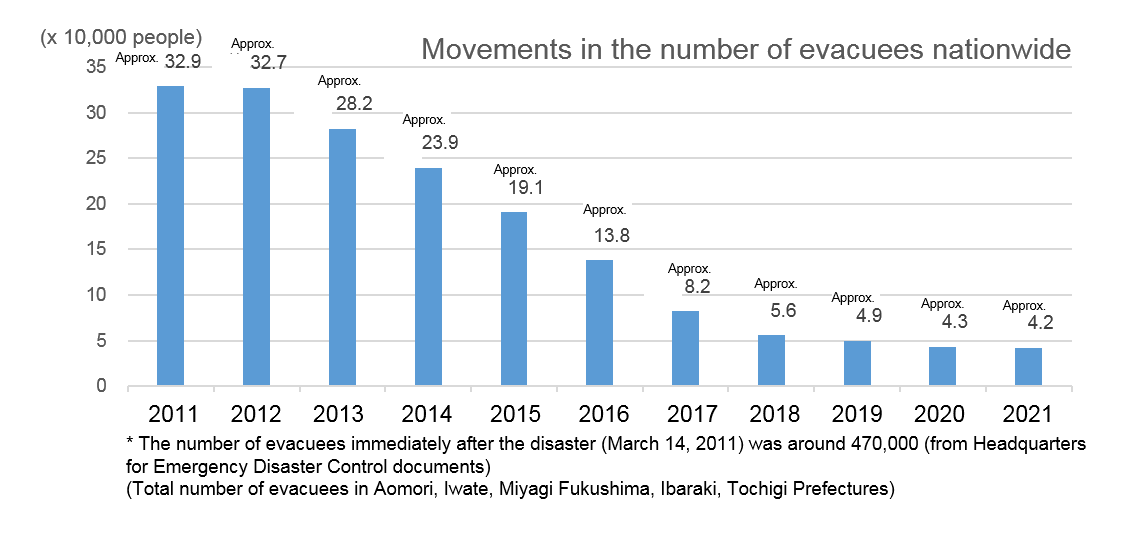
Support for sufferers / No. of occupied temporary housing residences / Movements in each of the three affected prefectures
- - The number of occupied temporary housing units dropped from 316,000 people to 1,000 people (March 2021).
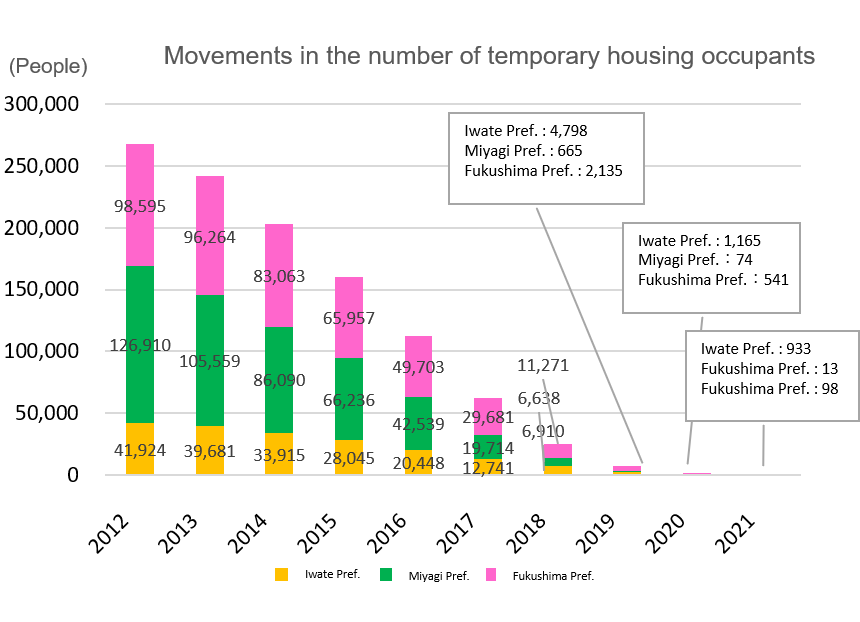
Source: Headquarters for Emergency Disaster Control, "The 2011 Tohoku Earthquake and Tsunami (Great East Japan Earthquake)"
Support for sufferers / No. of households with self-rebuilt homes / Movements in each of the three affected prefectures
- - Around 150,000 households have either self-rebuilt their homes, or are doing so.
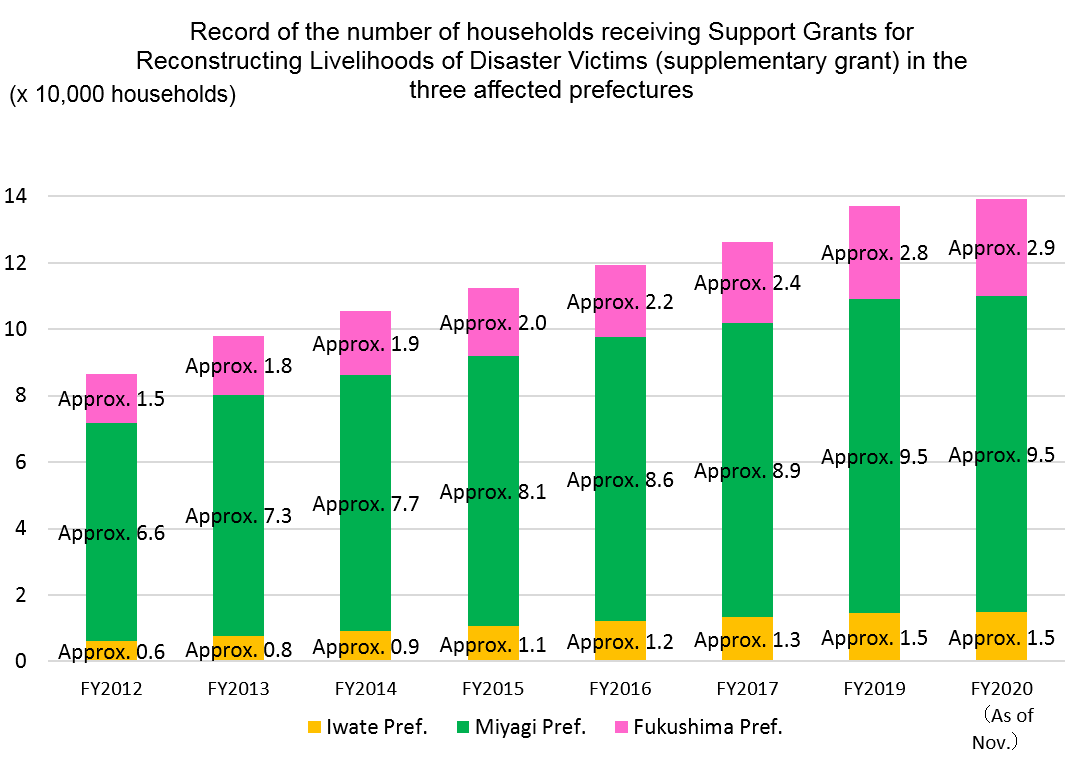
Source: Cabinet Office Disaster Management
For more details of support for sufferers
The prolongation of evacuation life, transfers to disaster public housing, and other factors make support
for community formation and meaningful living, physical and psychological care, and other support for
sufferers, an increasingly important challenge. The Reconstruction Agency positions such support as a key
policy measure.
The Agency provides seamless support, adapted to each person's stage of life reconstruction, amid the
prolongation of evacuation life and transfers to permanent housing. Measures include maintenance of
sufferers' mental and physical health, consultative support for rebuilding homes and livelihoods,
"emotional reconstruction" for community formation and meaningful living, and other support measures.
Reconstruction of homes and towns / Opening and extending reconstruction roads and reconstruction support roads
- - Of the 570 km of reconstruction roads and reconstruction support roads, approximately 86% have been opened(as of March 6, 2021).
- - The outlook is for almost all to be open within FY2020, apart from certain sections.
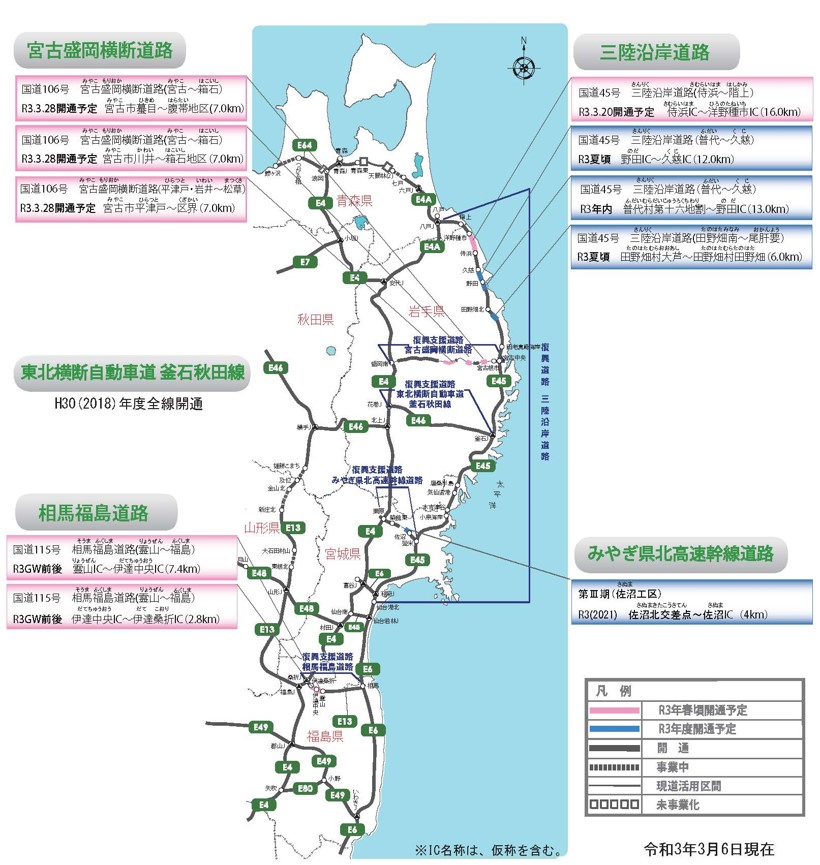
Reconstruction of homes and towns / Restoration and extension of railways
- - All of the 2,350.9km of disaster-affected roads in the three prefectures were reopened by March 2020.
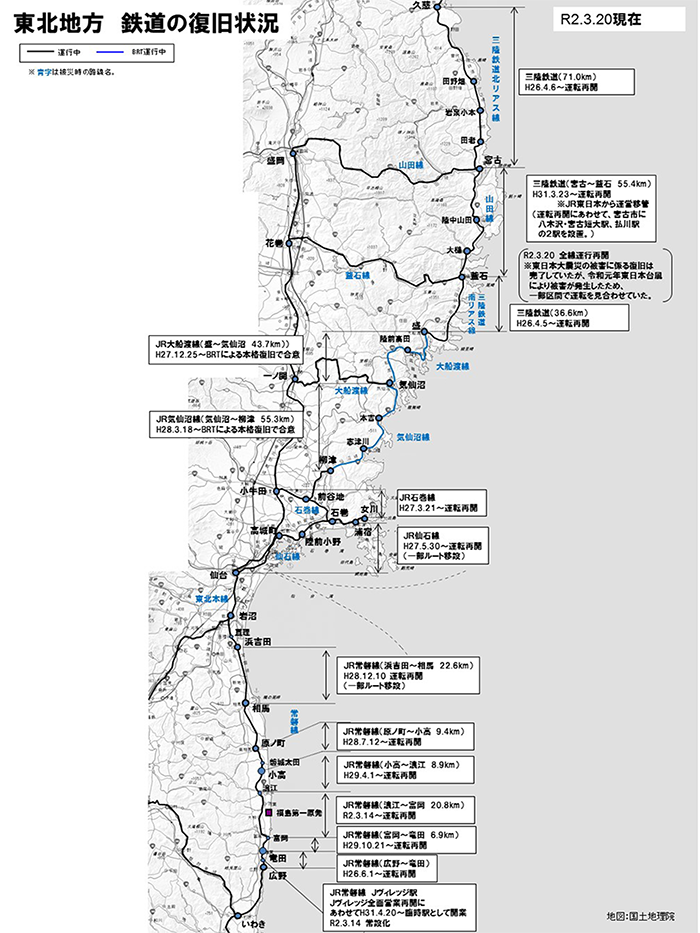
Reconstruction of homes and towns / Numbers of Disaster Public Housing units built / Movements in the three affected prefectures
- - The building of Disaster Public Housing was mostly complete by the end of FY2018, and entirely complete by December 2020.
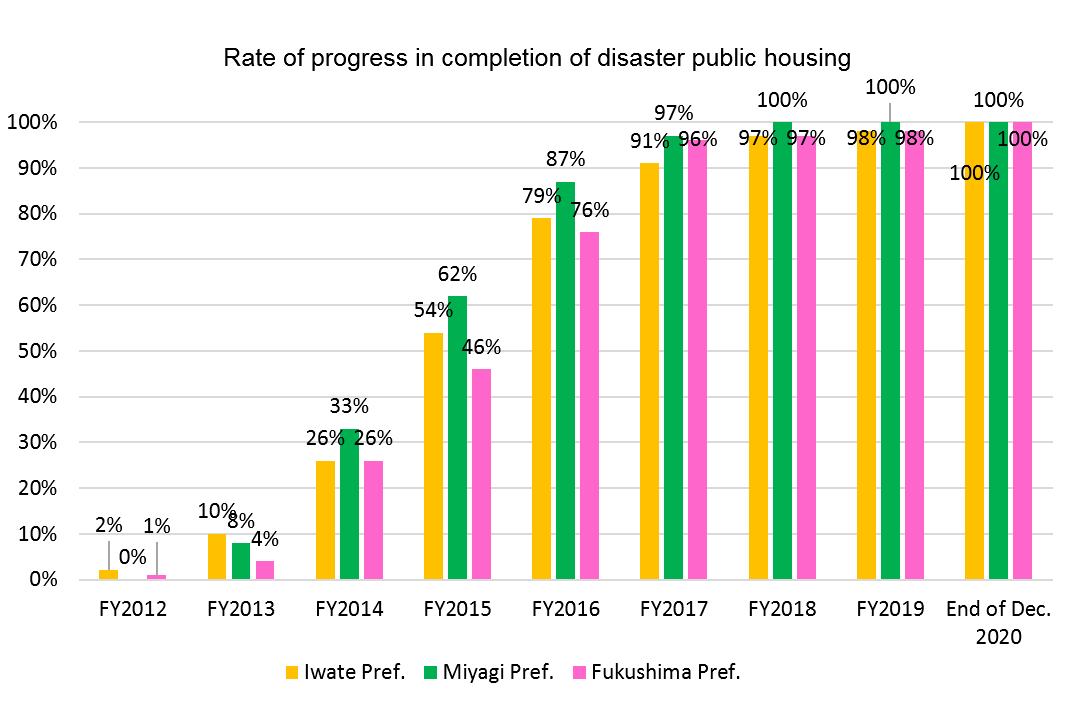
Source: Reconstruction Agency, "The supply of disaster public housing and residential land for private housing etc."
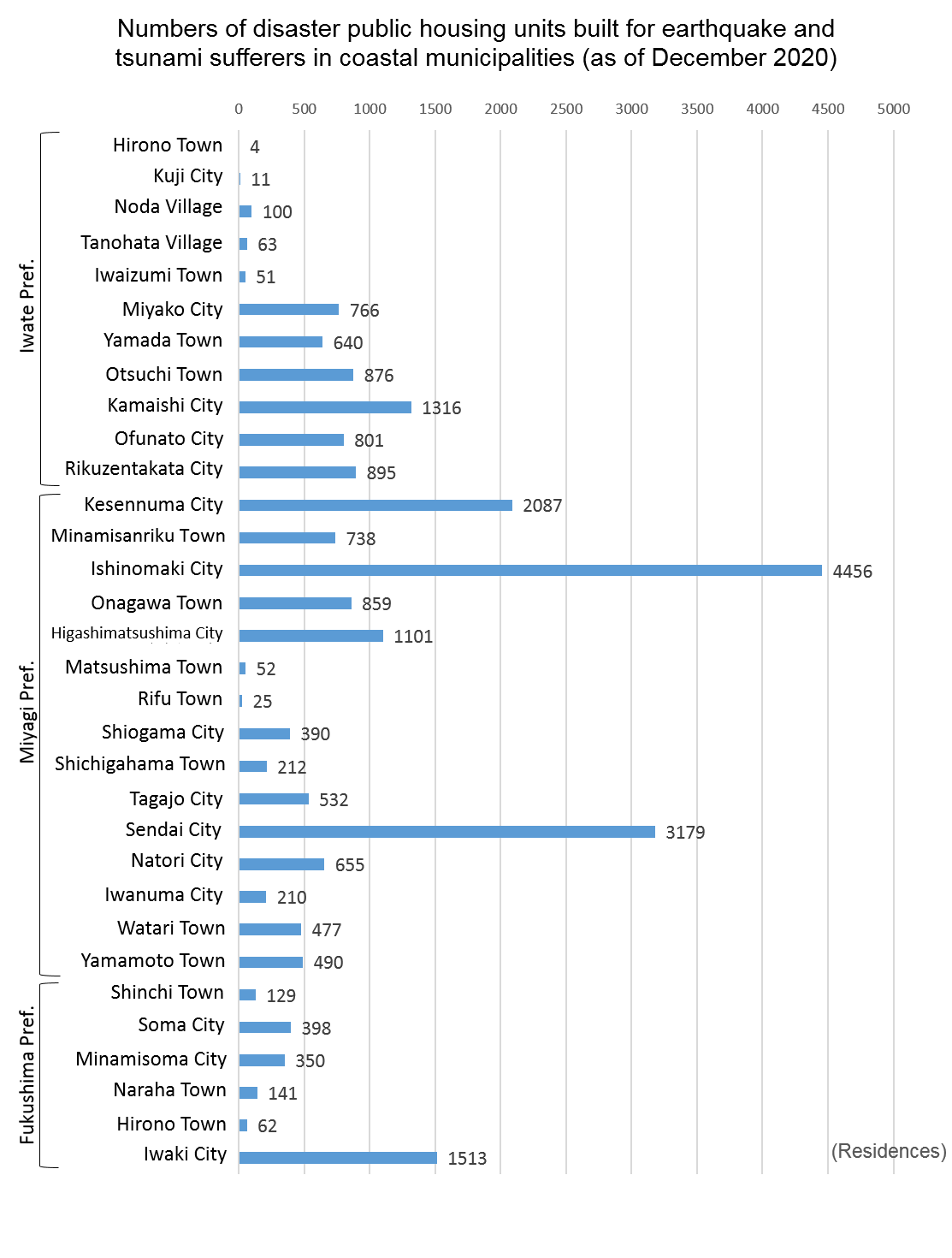
Source: Reconstruction Agency, "Home reconstruction work schedule"
Reconstruction of homes and towns / Numbers of residences relocated to higher ground / Movements in the three affected prefectures
- - The relocated development of housing to higher ground building was mostly complete by the end of FY2018, and entirely complete by December 2020.
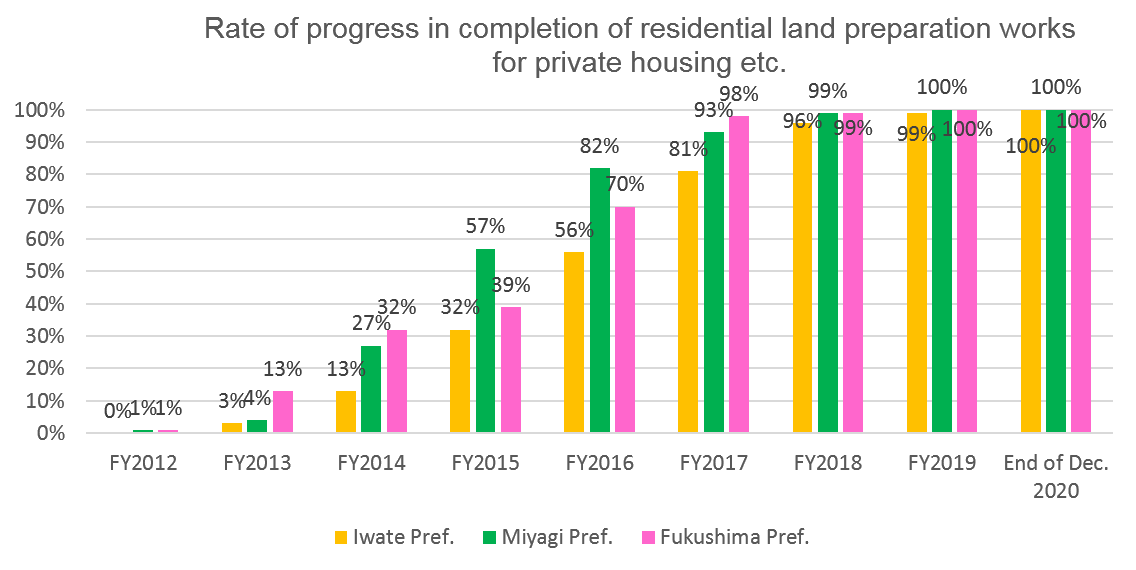
Source: Reconstruction Agency, "The supply of disaster public housing and residential land for private housing etc."
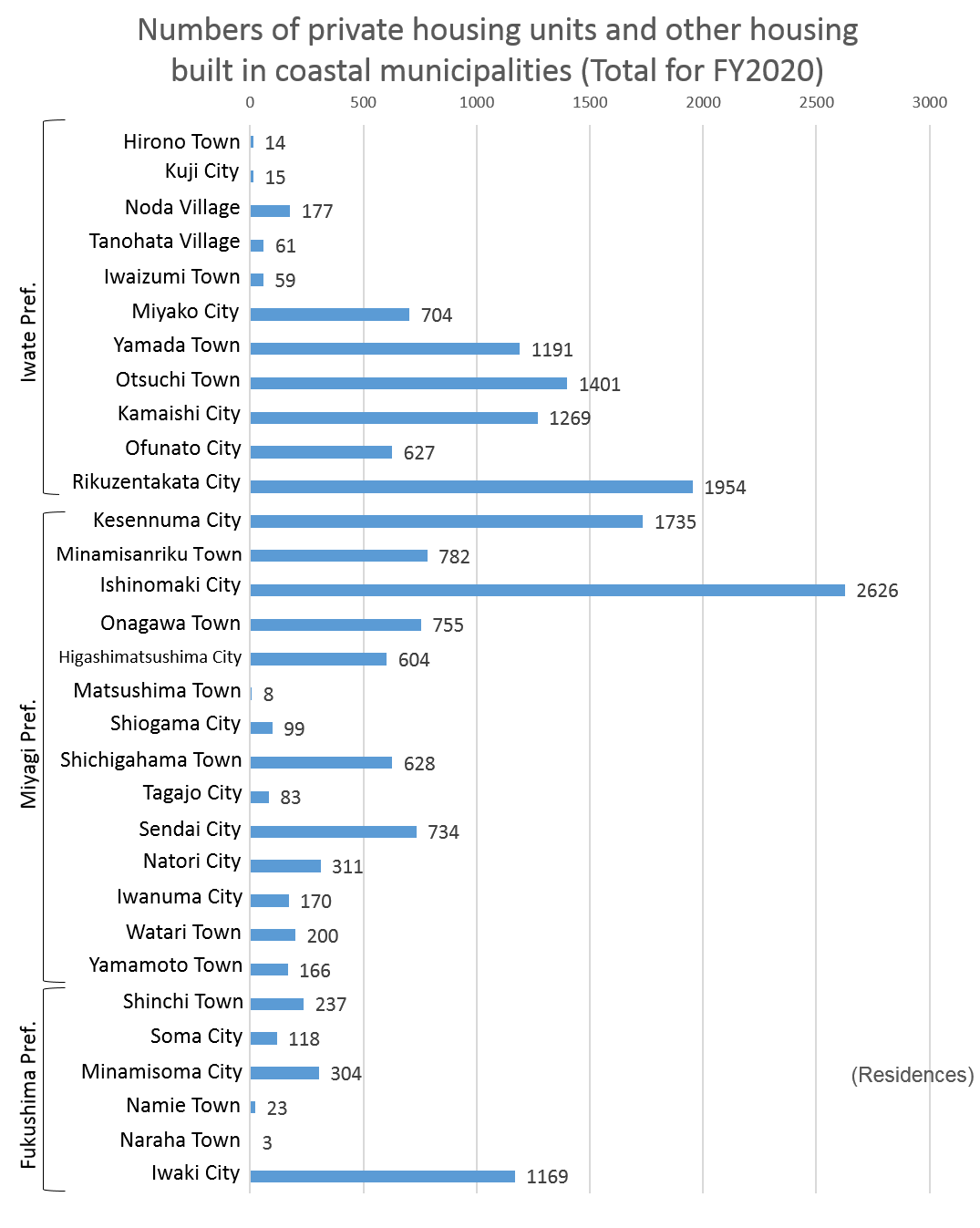
Source: Reconstruction Agency, "Home reconstruction work schedule"
Reconstruction of homes and towns / Area supplied by land readjustment projects
- - In Rikuzen Takata City in Iwate Prefecture, in Ishinomaki and Onagawa Town in Miyagi Prefecture, and elsewhere, land readjustment projects have been used for large-scale reconstruction urban development.
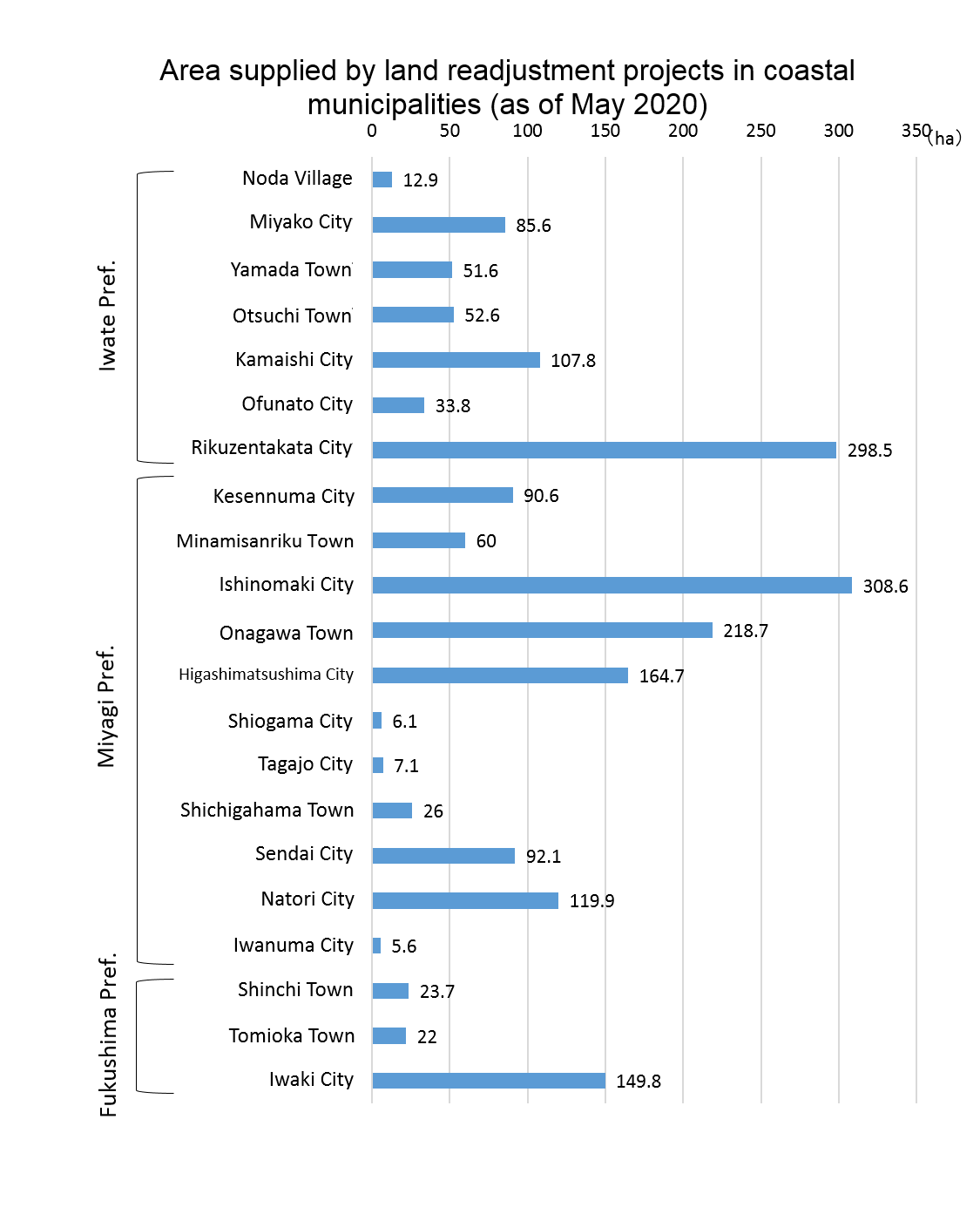
Source: The Ministry of Land, Infrastructure and Transport and Tourism
For more details of the history of disaster public housing and relocation to higher ground
[Reconstruction Agency] Home reconstruction work scheduleFormation of land by land readjustment projects, and use of land vacated by relocation by group relocation promotion projects for disaster prevention For information about related expertise
[Reconstruction Agency] Guidebook for the Promotion of Land Use in Disaster-affected Urban Areas(Edition for land formed by raising levee height)[Reconstruction Agency] Guidebook for the Promotion of Land Use in Disaster-affected Urban Areas(Edition for low-lying areas)
[Reconstruction Agency] Guidebook for the Promotion of Land Use in Disaster-affected Urban Areas(Edition for estimation of users)
For examples of the use of land vacated by relocation in group relocation promotion projects for disaster prevention
[Reconstruction Agency] Examples of the Use of Land Vacated by Relocation in Group Relocation Promotion Projects for Disaster Prevention (Additional Edition)[For those wishing to use land developed by land readjustment projects]
(Iwate Prefecture, Noda Village) Vacant Home Information Bank(Iwate Prefecture, Yamada Town) Looking for applicants to use land around National Route 45 in Yamada Town
(Iwate Prefecture, Otsuchi Town) Otsuchi Town Vacant Land Bank System
(Iwate Prefecture, Kamaishi City) Readjusted Land Usage Support System
(Iwate Prefecture, Ofunato City) Ofunato Station Area Land Use Matching Project
(Iwate Prefecture, Rikuzen Takata City) Land Use Promotion Bank
(Miyagi Prefecture, Kesennuma City) Entry system for reconstruction urban development business operators etc.
(Miyagi Prefecture, Minamisanriku Town) Sale of land from the Minamisanriku Town land readjustment project, and provision of information to would-be renters
(Miyagi Prefecture, Onagawa Town) Project for information provision on the use of vacant homes in Onagawa Town, and notification of lotting out and renting of town-owned land
(Miyagi Prefecture, Onagawa Town) Project for information provision on the use of vacant homes in Onagawa Town, and notification of lotting out and renting of town-owned land
(Miyagi Prefecture, Ishinomaki City) Applicants wanted for lotting out (renting) city-owned land from the Ishinomaki City Disaster-affected Urban Area Reconstruction Land Readjustment Project (Business applicants wanted to locate businesses in the industrial zone)
(Miyagi Prefecture, Higashi Matsushima City) Applicants wanted for lotting out or renting land for business premises in the Omagarihama district
(Miyagi Prefecture, Shichigahama Town) Business operator applicants wanted for Hanabuchihama district commercial and industrial sites, and for Yogasakihama district A industrial sites (rental)
(Miyagi Prefecture, Sendai City) Business operator applicants wanted, to use city-owned land in the Gamo Hokubu district
(Fukushima Prefecture, Shinchi Town) Shinchi Town Vacant Home and Land Bank
(Fukushima Prefecture, Iwaki City) Iwaki City Vacant Land Bank (within the implementation area of the coastal five districts land readjustment project)
Regeneration of Industry and livelihoods / Gross domestic product / Movements in the three affected prefectures (including breakdown)
- - The damage from the Great East Japan Earthquake mostly reduced the gross domestic product of the three prefectures in 2011, but it has increased since 2012, centered on construction.
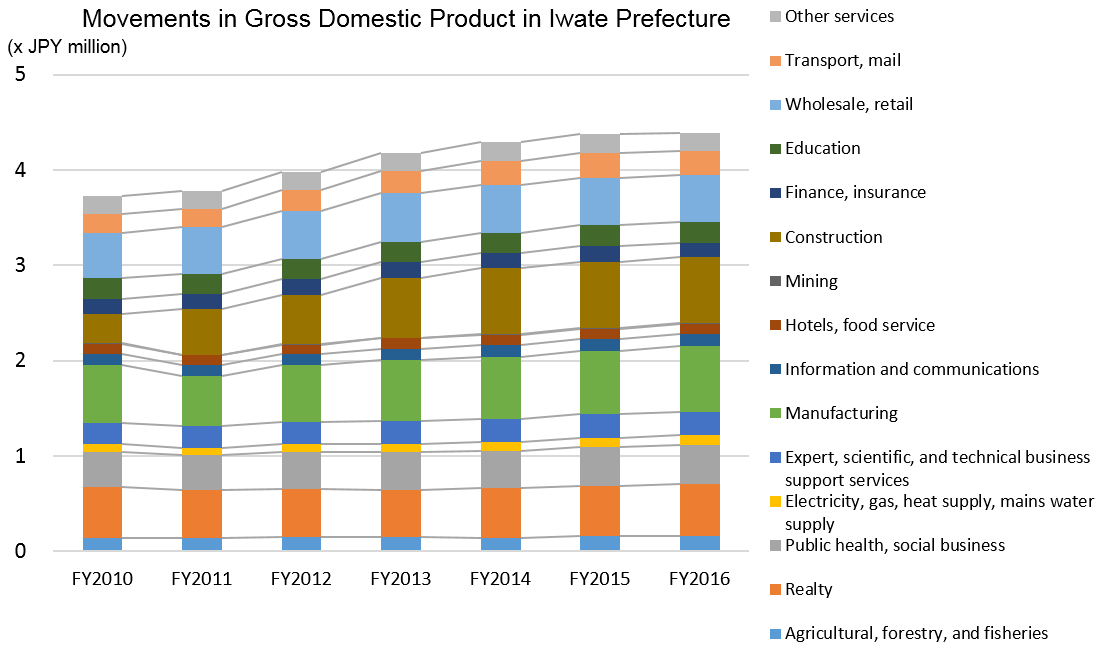
Source: Iwate Prefecture, “Almanac of municipal economic calculations for Iwate Prefecture”
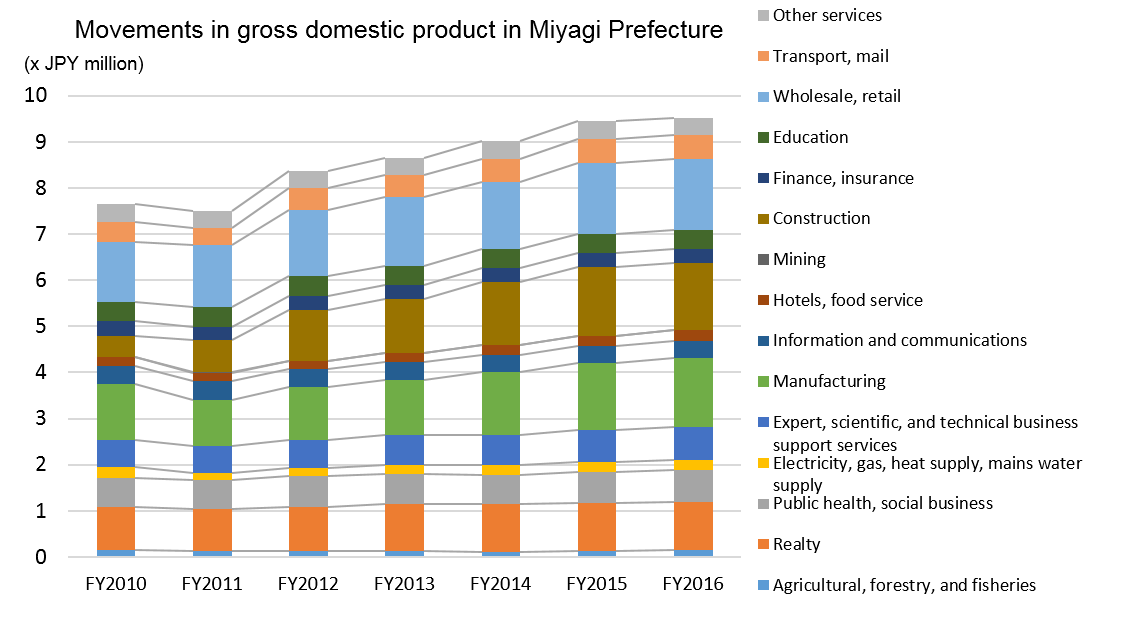
Source: Miyagi Prefecture, “Almanac of municipal economic calculations for Miyagi Prefecture”
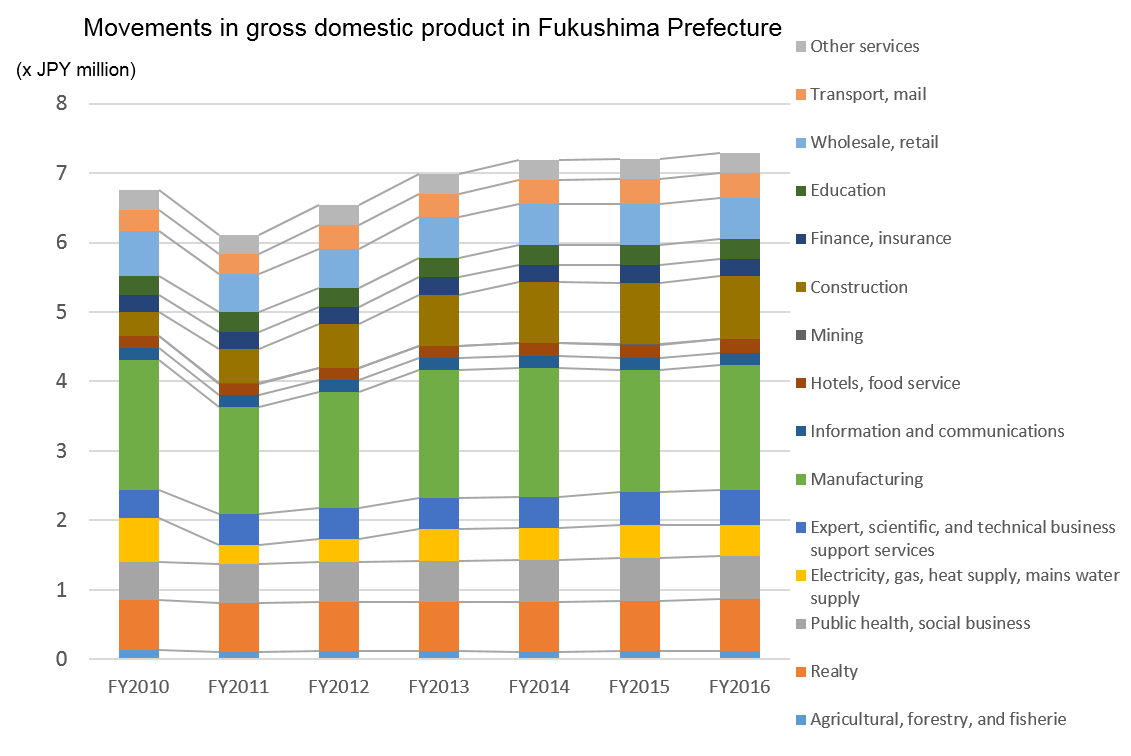
Source: Fukushima Prefecture, “Almanac of municipal economic calculations for Fukushima Prefecture”
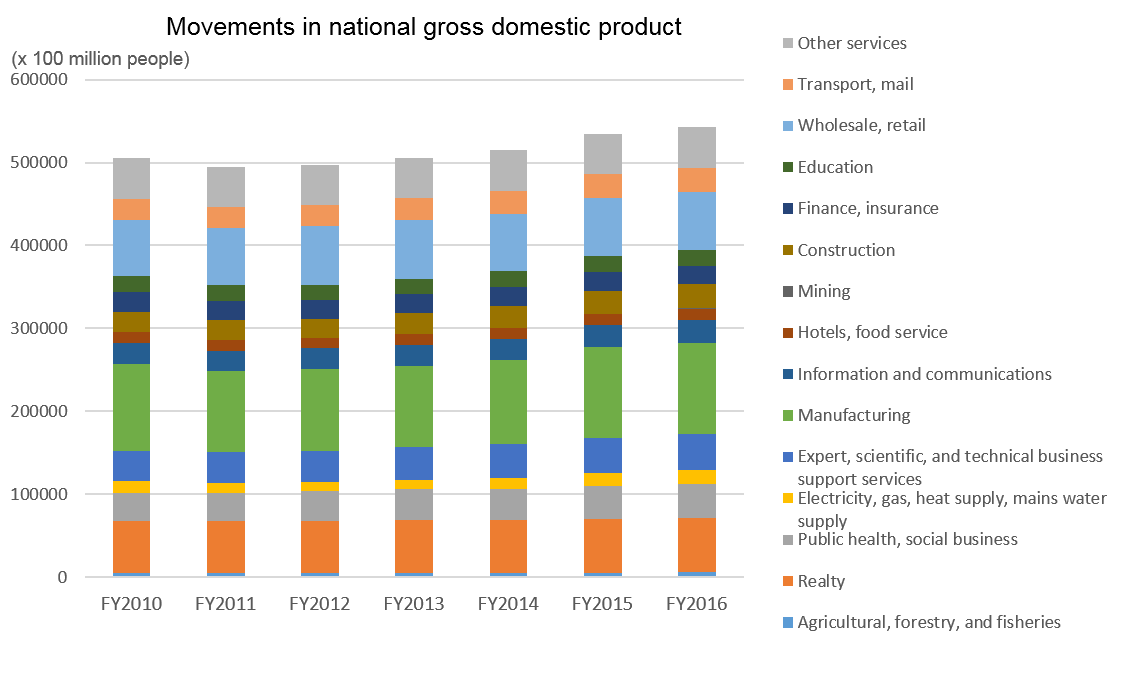
Regeneration of Industry and livelihoods / Current management issues in the group subsidy questionnaire survey / Movements in the three affected prefectures
- - Of the management issues faced by small and medium enterprises which used group subsidies, the most common were “Hiring and training personnel” (“Hiring and training employees”, “Hiring and training management personnel”) and “Finding and developing sales channels.”
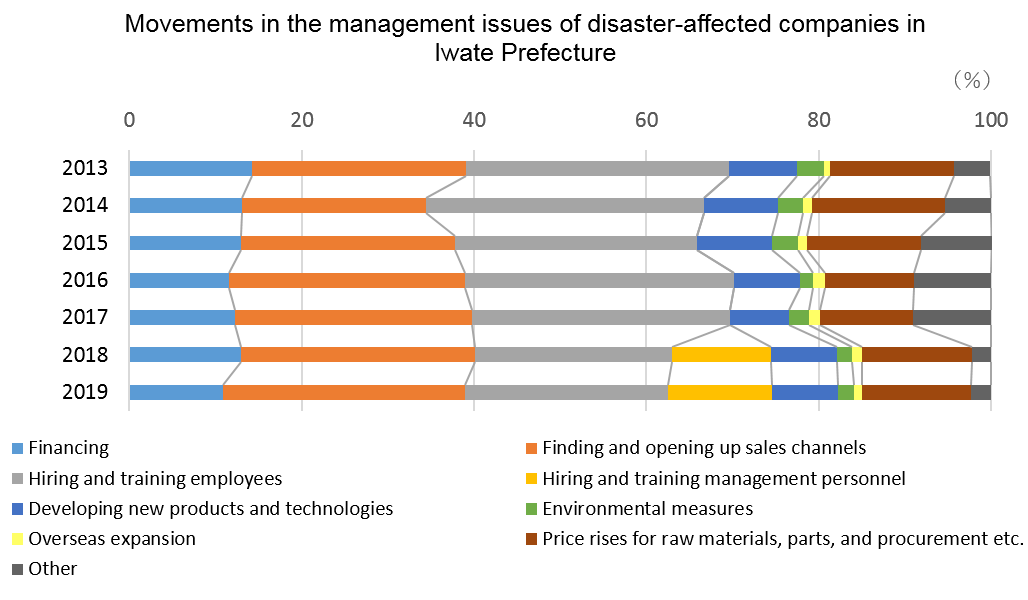
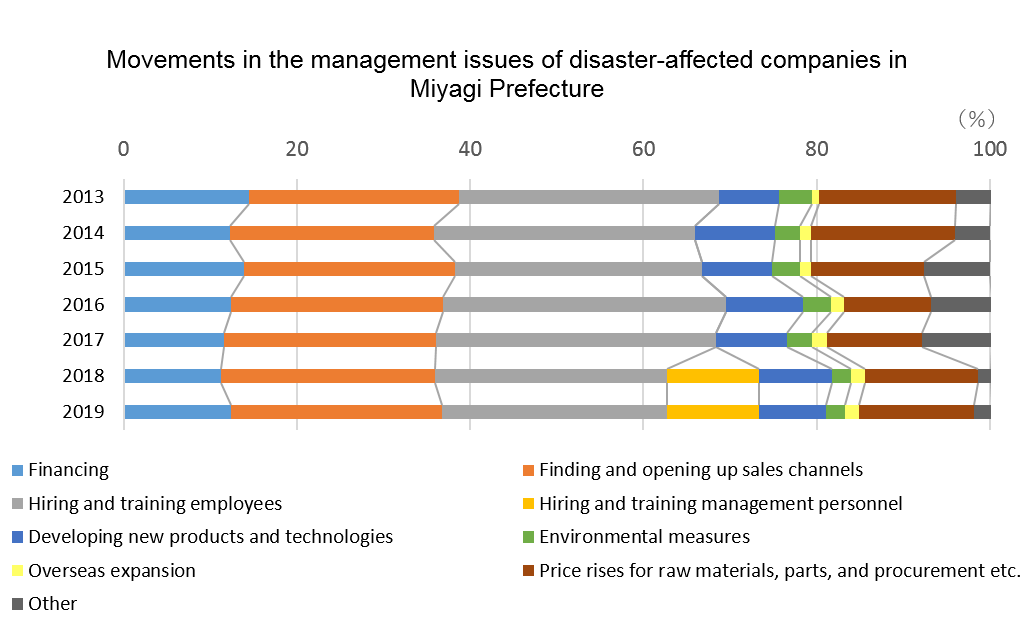
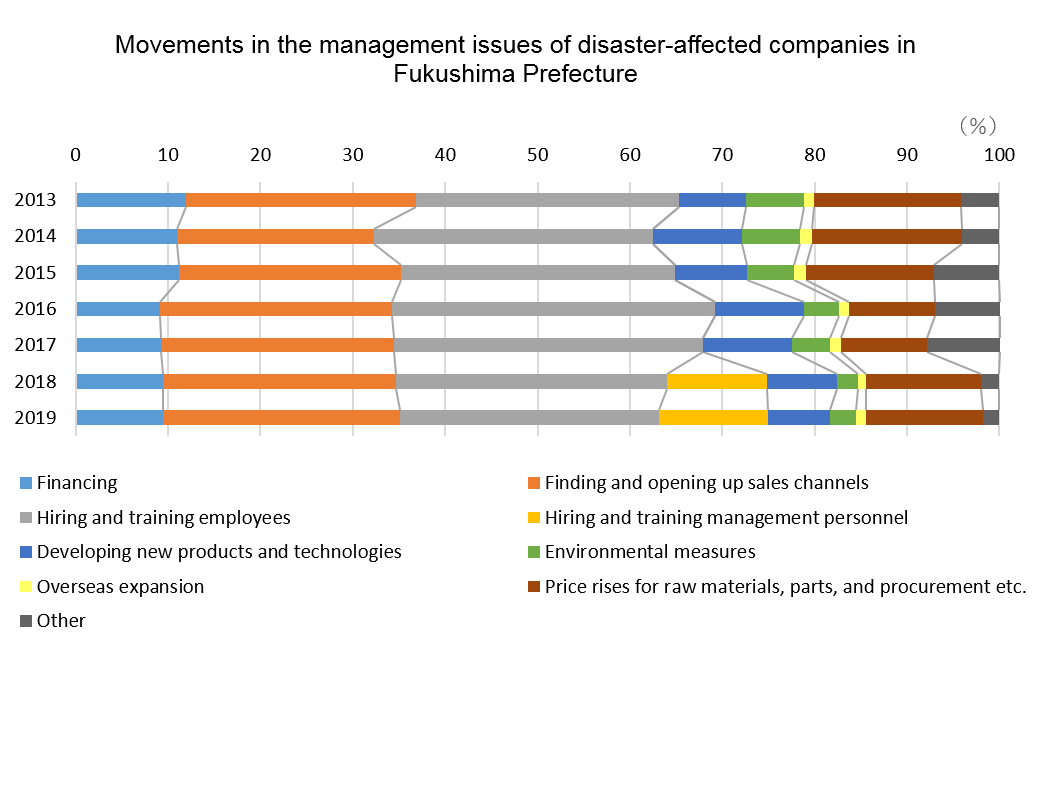
Responses for each issue / Total number of responses
Regeneration of Industry and livelihoods / Manufactured product shipment prices/ Movements in the three affected prefectures
- - Iwate and Miyagi prefectures have growth rates above the national average, and even Fukushima Prefecture has recovered to its pre-disaster level
- - On the other hand, there are areas in the coastal regions of the three affected prefectures where recovery is delayed.
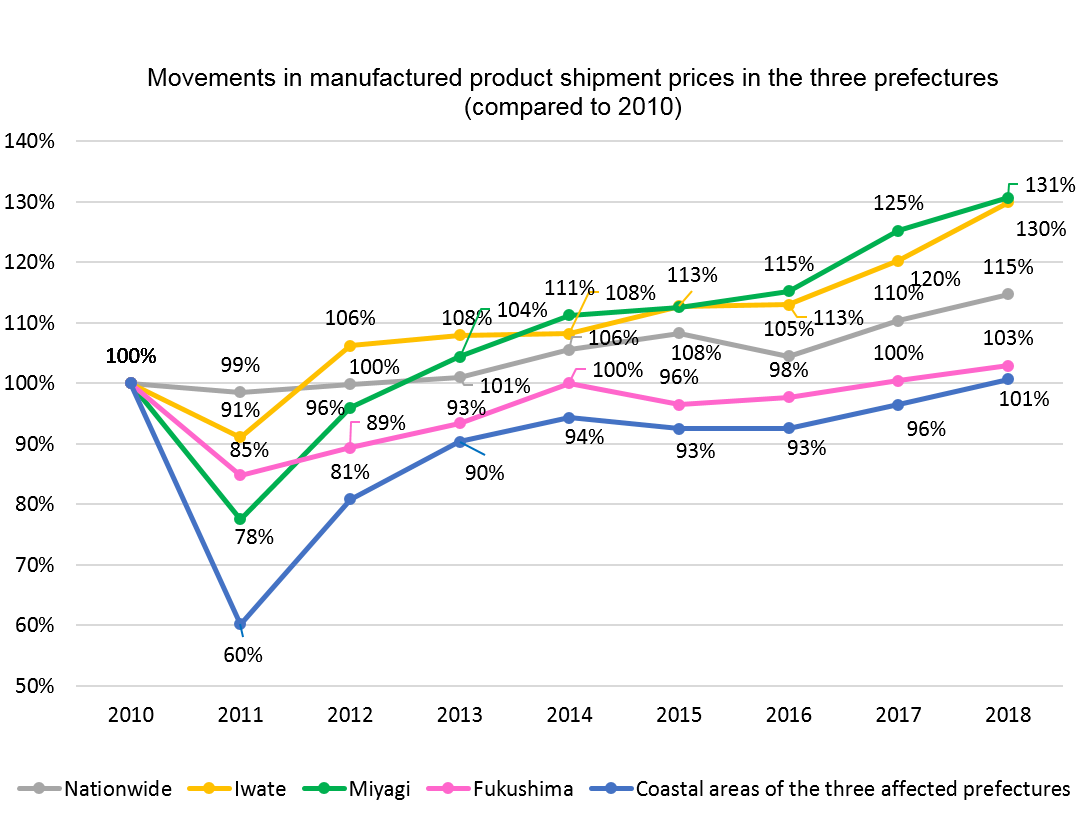
Source: Prepared by the Reconstruction Agency on the basis of the Ministry of Economy, Trade and Industry “2010 Survey of Industrial Statistics”, “2012 Survey of Industrial Statistics”, “2013 Survey of Industrial Statistics”, “2014 Survey of Industrial Statistics”, “2017 Survey of Industrial Statistics (records from 2016)”, “2018 Survey of Industrial Statistics (records from 2017)”, Ministry of Internal Affairs and Communications and Ministry of Economy, Trade and Industry “2012 Economic Census and Activity Survey (records from 2011)”, “2016 Economic Census and Activity Survey (records from 2015)”, and “2019 Survey of Industrial Statistics (records from 2018)”
Regeneration of Industry and livelihoods / Value of agricultural production / Movements in the three affected prefectures
- - Iwate and Miyagi prefectures moved in line with national trends, at levels higher than before the disaster.
- - Fukushima Prefecture has yet to recover to its level from before the disaster, but it has been trending upwards in recent years.
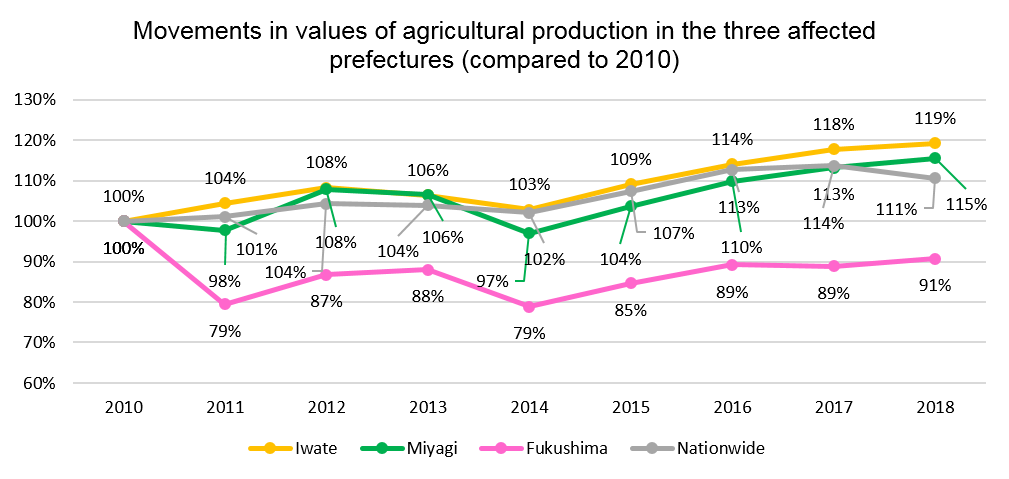
Source: Ministry of Agriculture, Forestry and Fisheries, “Forestry output”
Regeneration of Industry and livelihoods / Value of forestry production / Movements in the three affected prefectures
- - Iwate and Miyagi prefectures are broadly maintaining the same levels as before the disaster.
- - Fukushima Prefecture dropped substantially immediately after the disaster, but has recently recovered to 80% of pre-disaster levels.
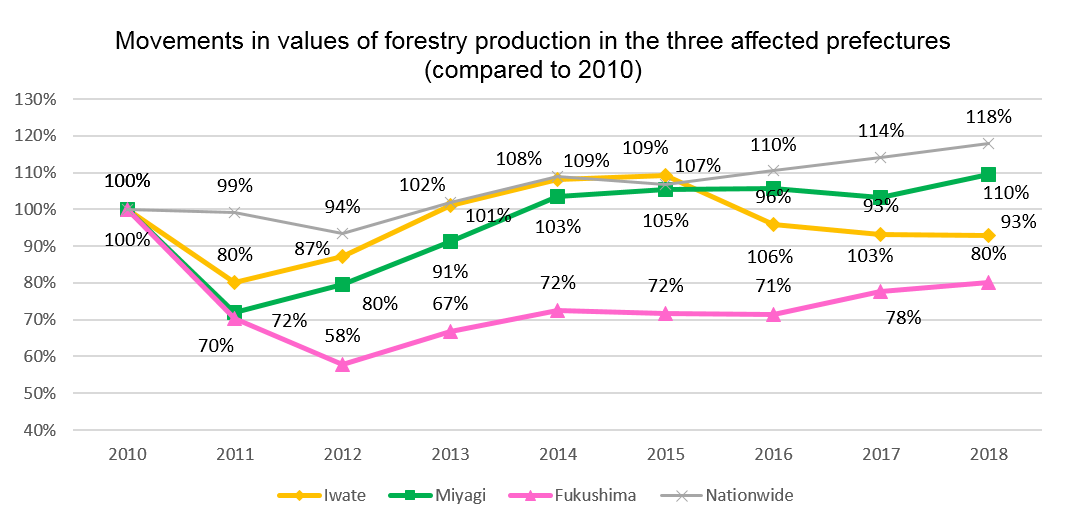
Source: Ministry of Agriculture, Forestry and Fisheries, “Forestry output”
Regeneration of Industry and livelihoods / Catches of each fish type / Movements in the three affected prefectures
- - In recent years, Iwate and Miyagi Prefectures are moving at around 50-70% of pre-disaster levels. But, there are major variations between years and between fish types.
- - In Fukushima Prefecture, catches dropped substantially immediately after the disaster, and fisheries are still working towards resuming full operations.
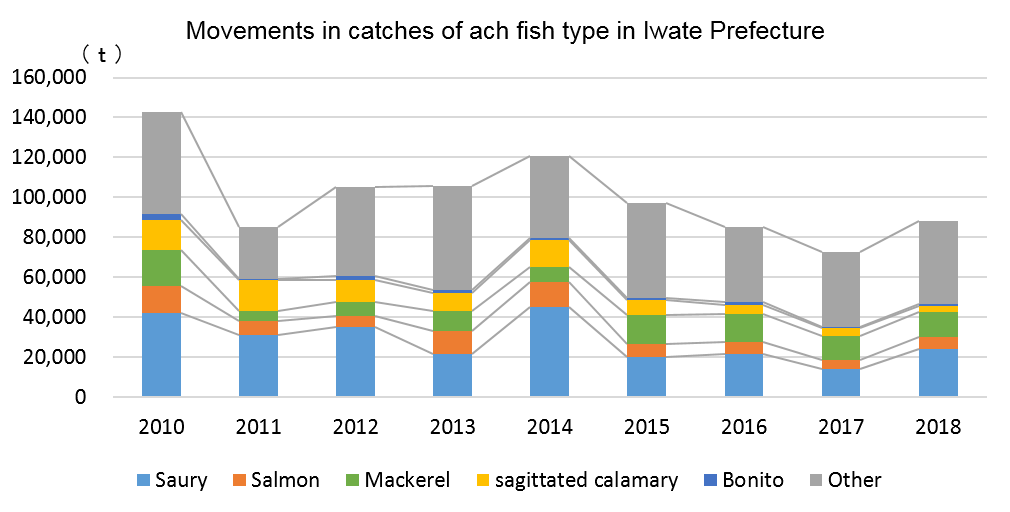
Source: Fisheries Agency, “Survey of Aquatic Produce Distribution”
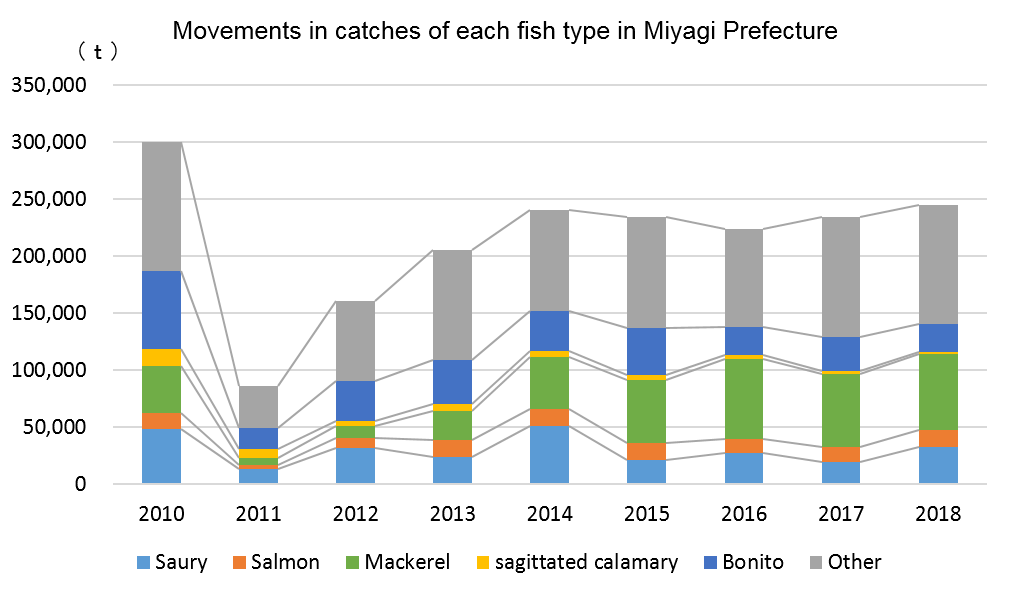
Source: Fisheries Agency, “Survey of Aquatic Produce Distribution”
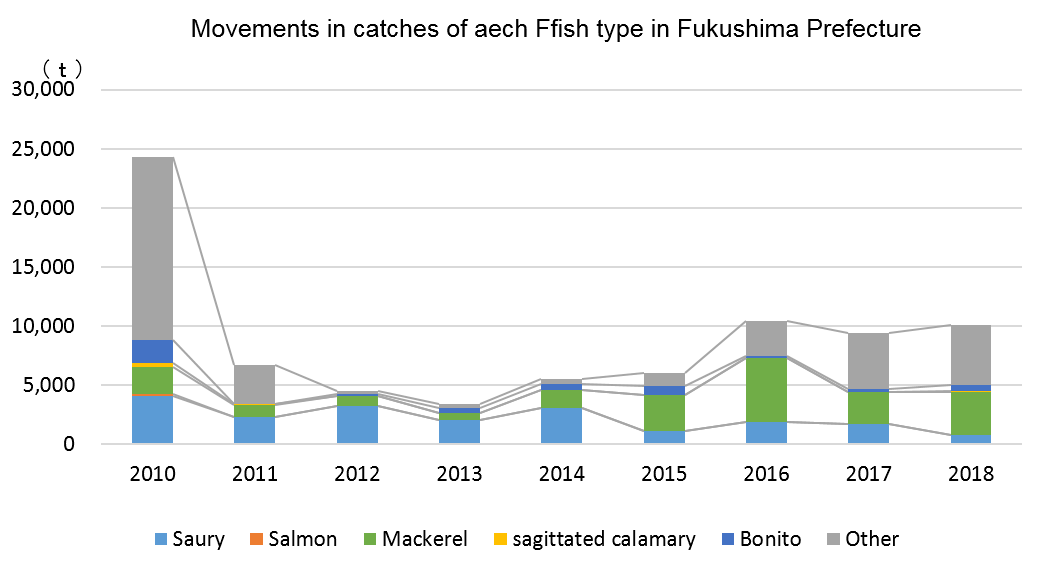
Source: Fisheries Agency, “Survey of Aquatic Produce Distribution”
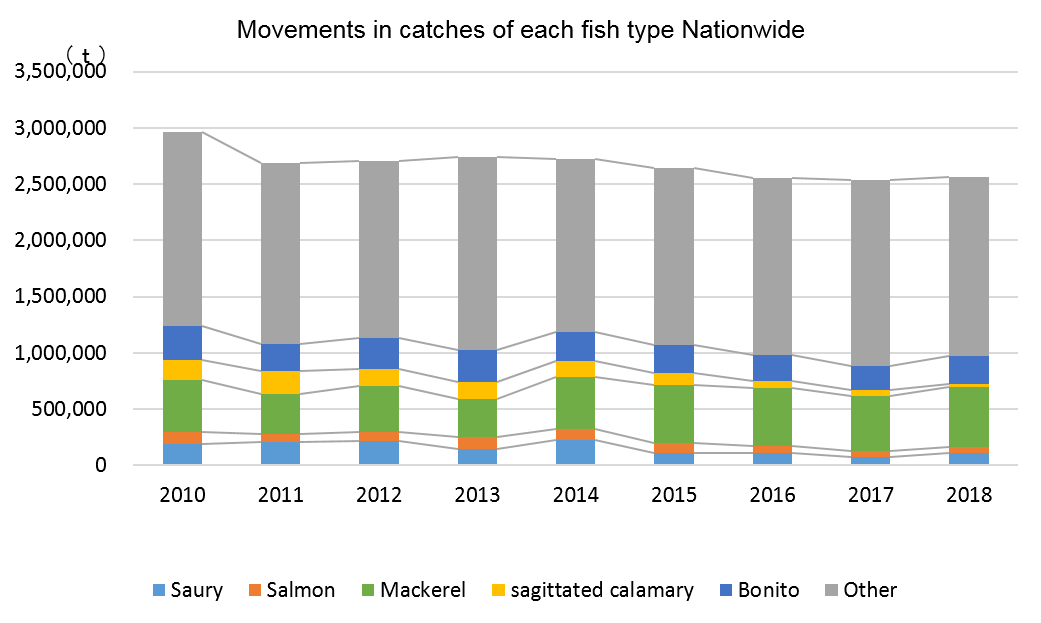
Source: Fisheries Agency, “Survey of Aquatic Produce Distribution”
Regeneration of Industry and livelihoods / Total foreigner hotel stays / Movements in the three affected prefectures
- - The total number of hotel stays by foreigners in the six prefectures of the Tohoku region in 2019 was 1.68 million person-nights, surpassing the target of 1.5 million person-nights by 2020.
- - In Fukushima Prefecture, on the other hand, the growth rate in total foreigner hotel stays was lower than the national level.
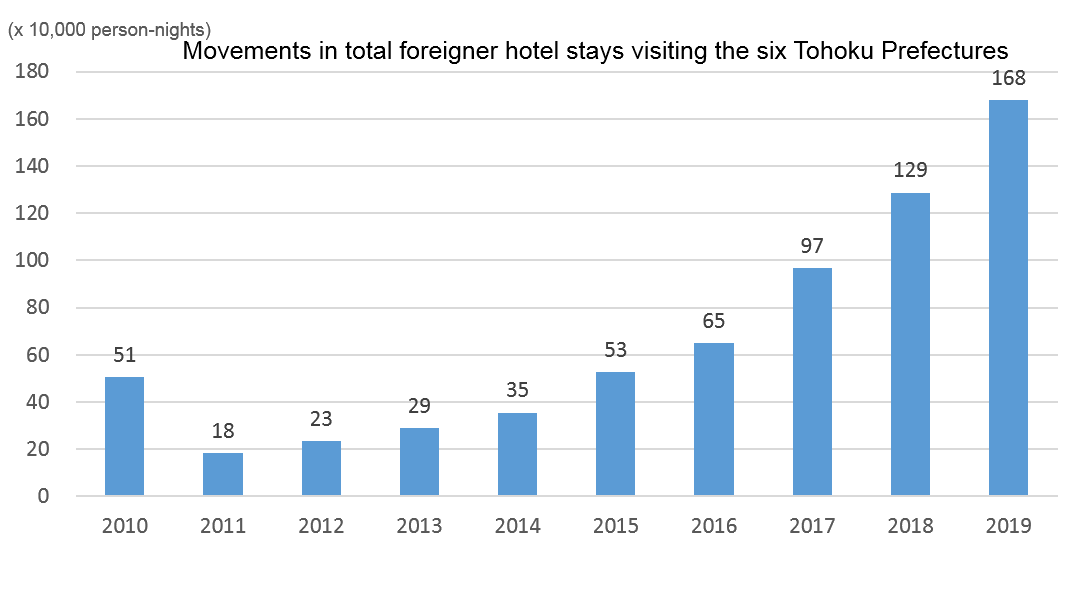
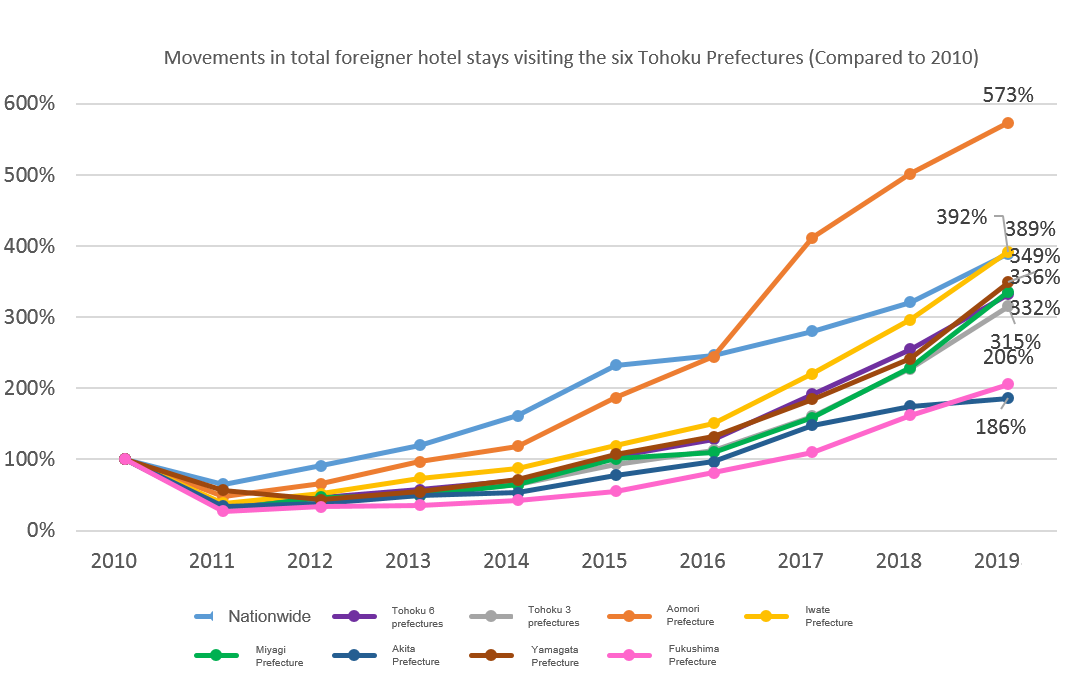
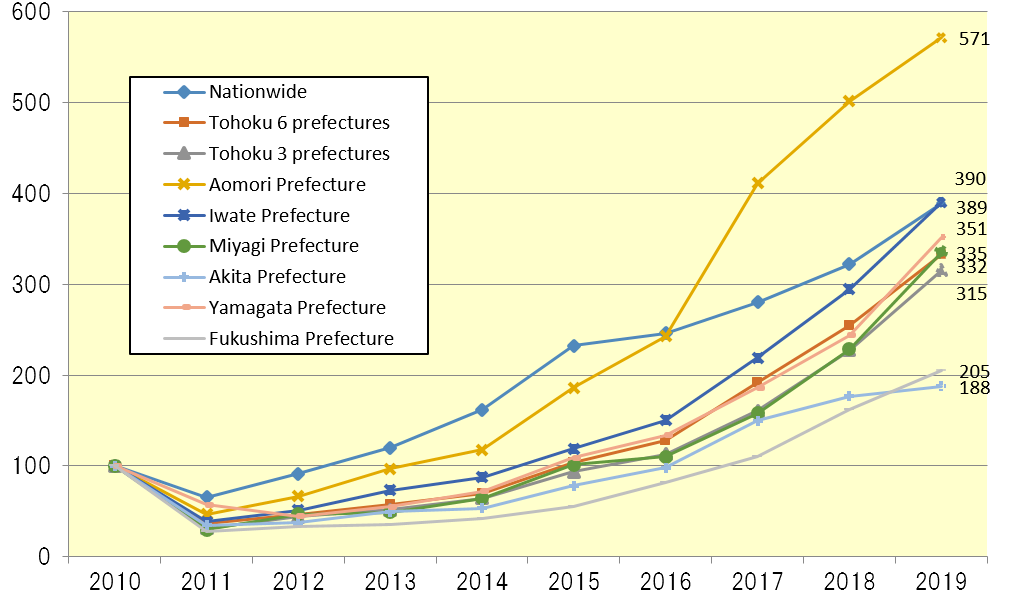
Reconstruction and regeneration from the reactor disaster / Numbers of residents
- - In regional authorities which lifted evacuation orders earlier, around 80% of residents have returned, but in other municipalities the return of residents is only partial.
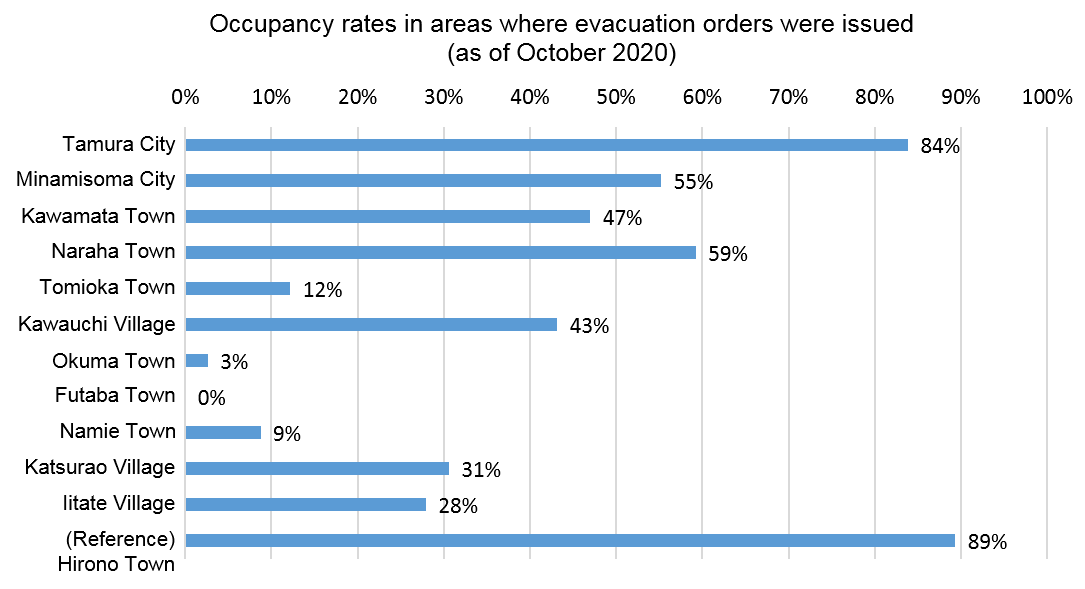
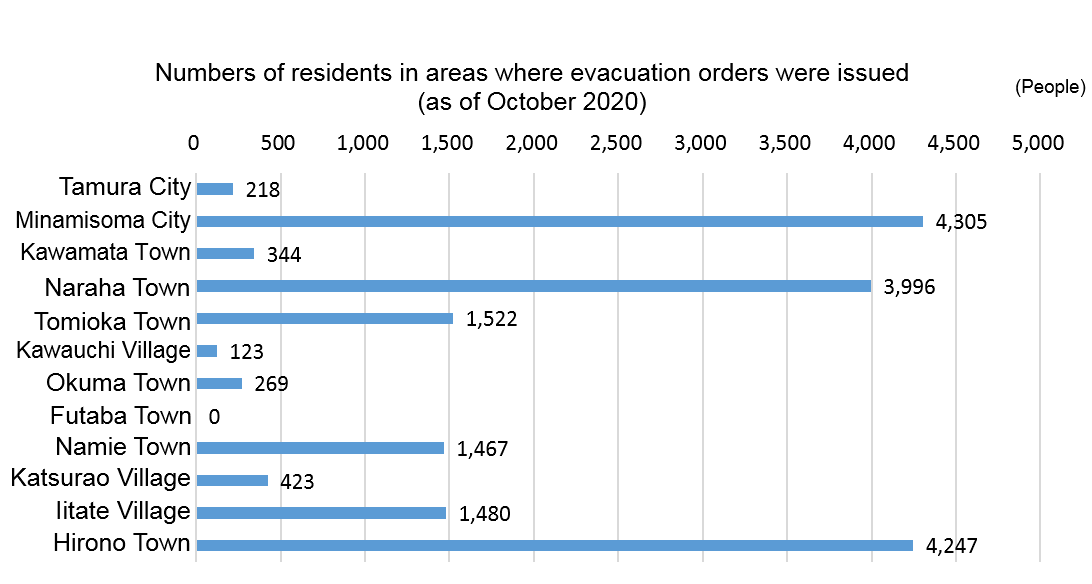
Sources: Surveys by each regional authority (as of October 2020)
For people interested in relocating to Hamadori (coastal areas) in Fukushima Prefecture
Reconstruction and regeneration from the reactor disaster / Land area of evacuation order areas / Movements
- - Evacuation orders are gradually being lifted, and their land area has been reduced to 29% of their maximum extent.
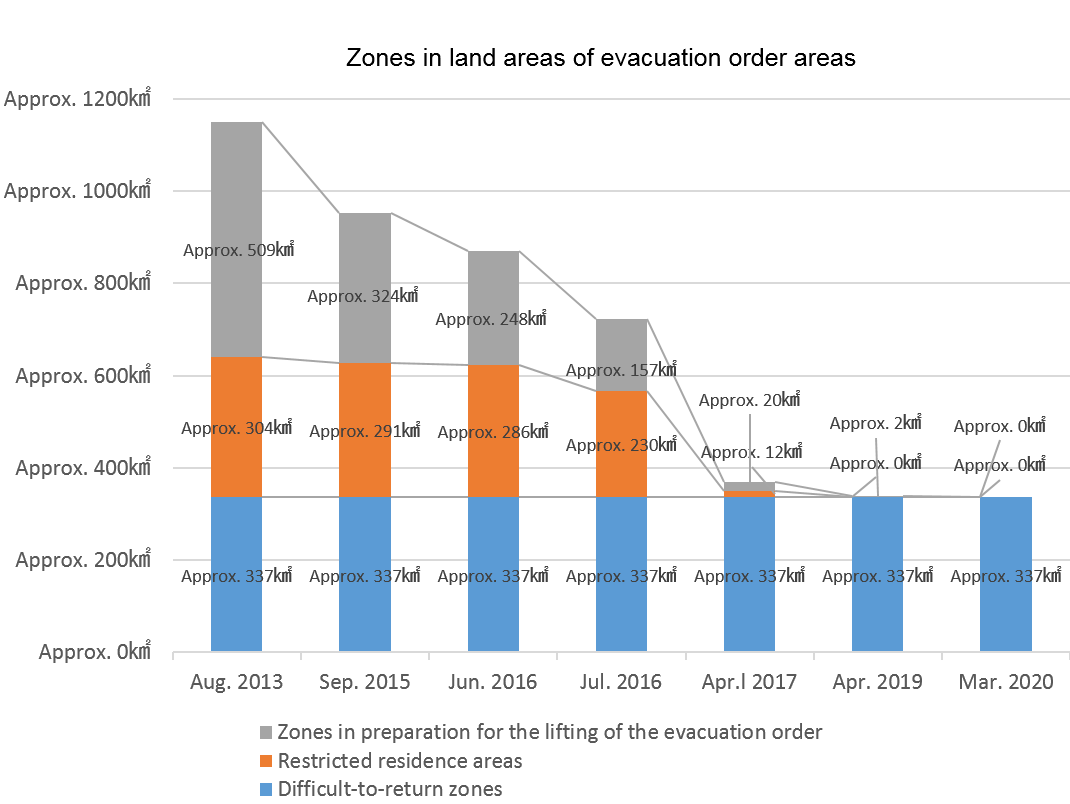
Source: Ministry of Economy, Trade and Industry
Reconstruction and regeneration from the reactor disaster / Numbers of evacuees in the whole of Fukushima Prefecture/ Movements
- - The number of evacuees in the whole of Fukushima Prefecture has declined from a peak of 165,000 to 36,000 people (as of January 2021)
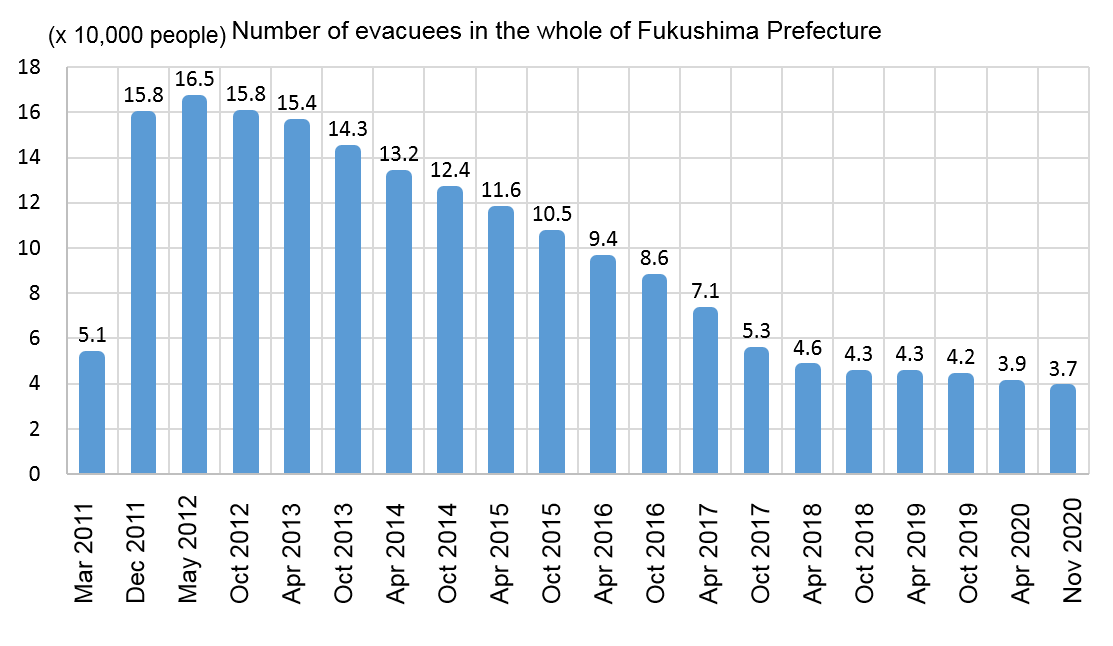
Source: Fukushima Prefecture, “Status Bulletin on Damage due to the 2011 Tohoku Earthquake and Tsunami”
・Around 50-60% said they were “not returning”, while around 30-40% said they “want to return” or are “undecided”, with variation between the regions .
- Survey of resident intentions in the municipalities affected by the reactor disaster
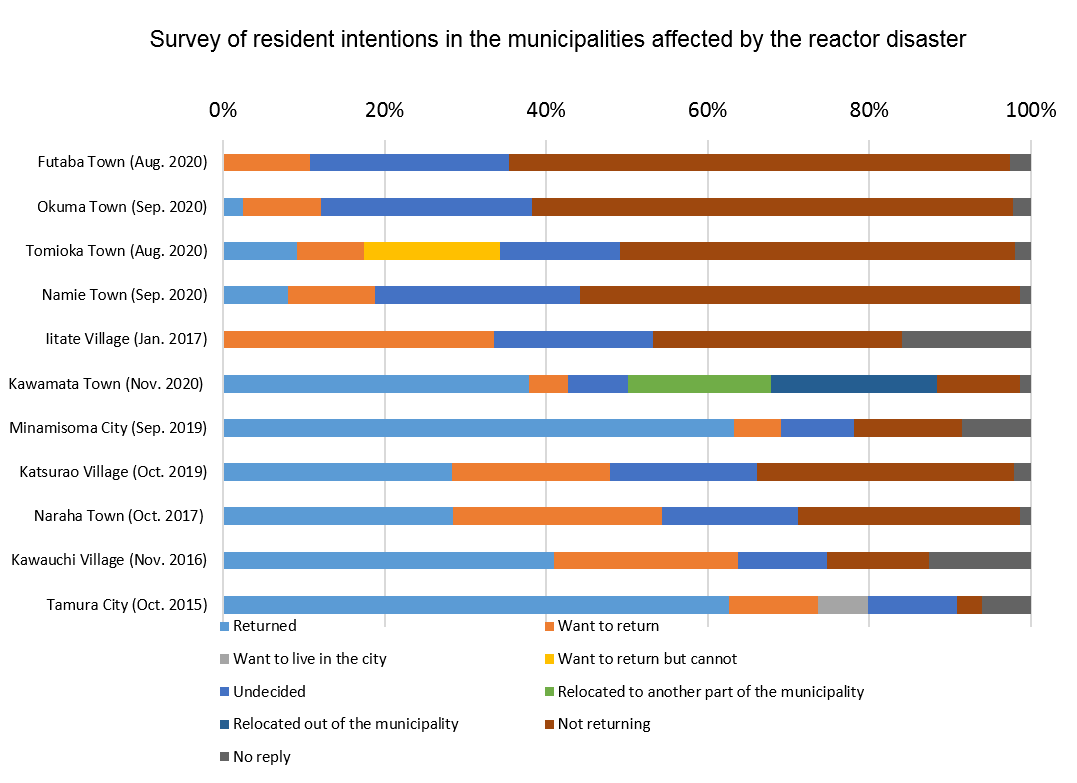
* Prepared on the basis of “Results of a 2020 survey of resident intentions in regional authorities
affected by the reactor disaster (summary)” (published by the Reconstruction Agency on February 19,
2021). (Using results from 2019 for Minamisoma City and KatsuraoVillage, from 2017 for NarahaTown, 2016
for Iitate Village and Kawauchi Village, and 2015 for Tamura City).
* Figures in ( ) are the dates of the surveys.
* Keys for each municipality have been modified in some areas for convenience.
Source: Reconstruction Agency “Survey of resident intentions in the municipalities affected by the reactor disaster”
Reconstruction and regeneration from the reactor disaster / Proportion of consumers reluctant to purchase produce from Fukushima Prefecture/ Movements
- ・Numbers of people who are reluctant to purchase produce from Fukushima Prefecture because of radioactive substances are declining, with recent surveys recording the lowest levels.
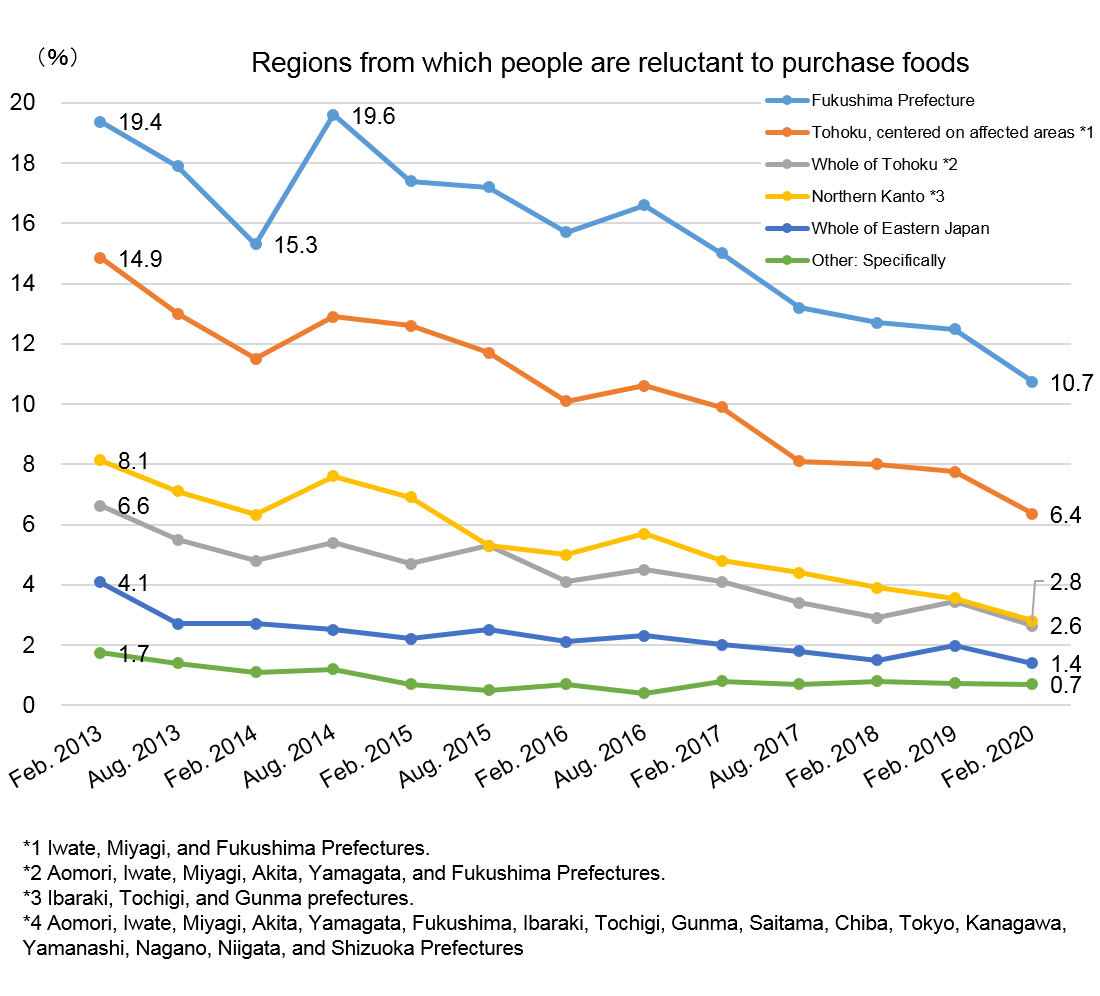
Fukushima practices strict testing to ensure that agricultural, forestry, and fisheries produce which exceeds standards for radioactive substances does not reach the market. Please check the site below for test results, and for information about attractive Fukushima produce.
Reconstruction and regeneration from the reactor disaster / Price disparity between Fukushima produce and the national average/ Movements
- ・Price disparities between Fukushima produce and the national average is trending towards recovery, but are becoming entrenched for some categories, namely beef and peaches.
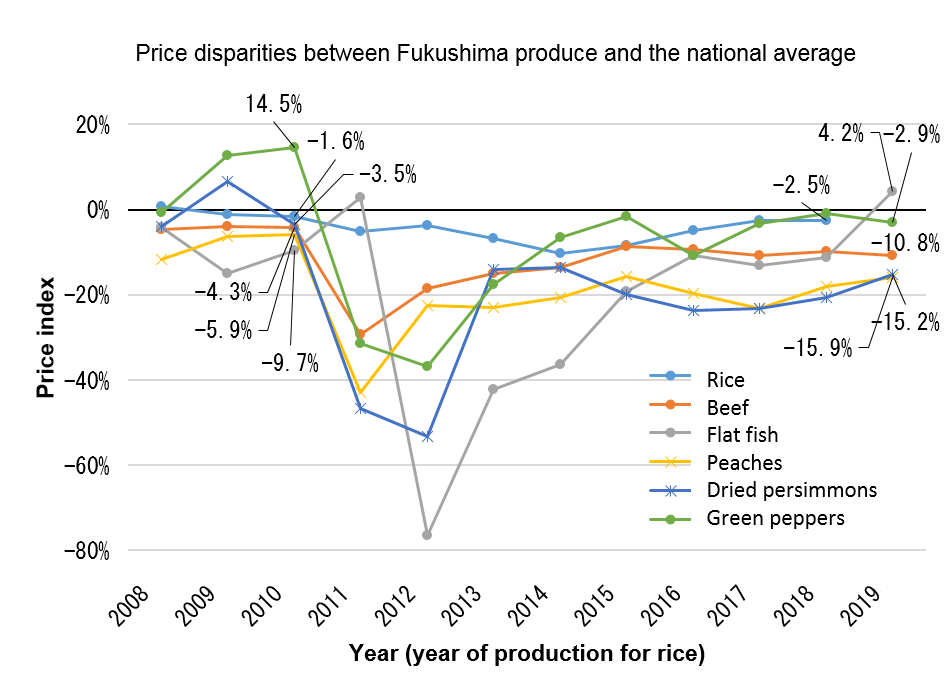
Source: Ministry of Agriculture, Forestry and Fisheries, “Fact-finding survey of the distribution of agricultural produce from Fukushima Prefecture”
Reconstruction and regeneration from the reactor disaster / Countries imposing import restrictions
- ・Of 54 countries and regions which imposed import restrictions, 39 have fully abolished them, and 13 have relaxed them (as of January 2021)
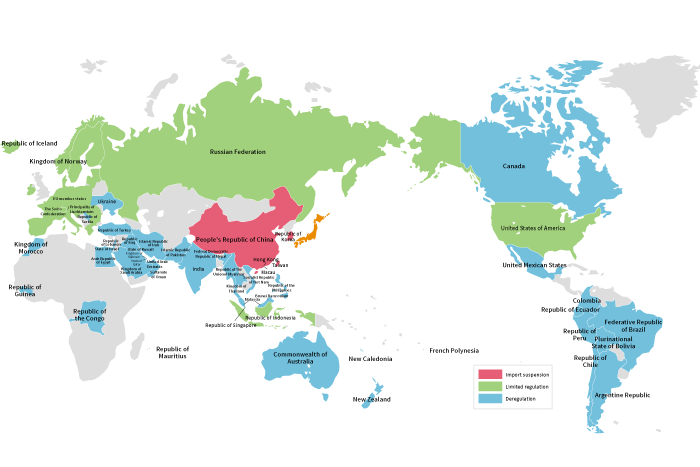
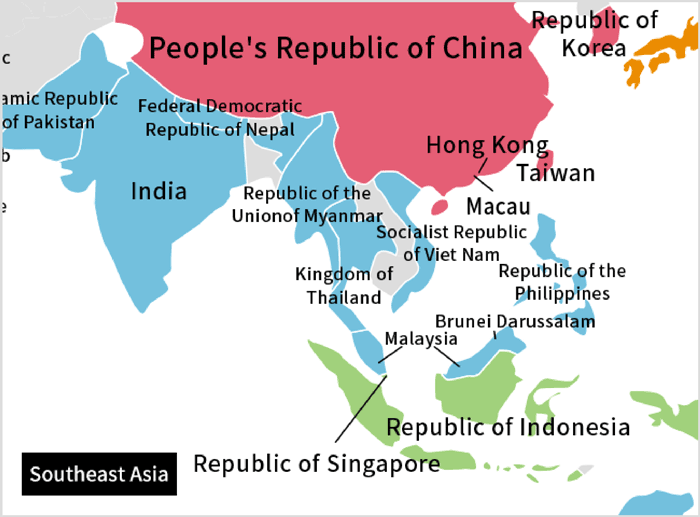
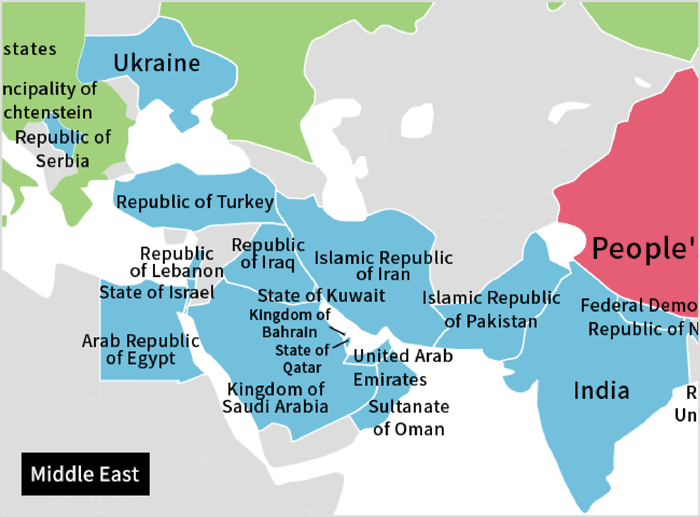

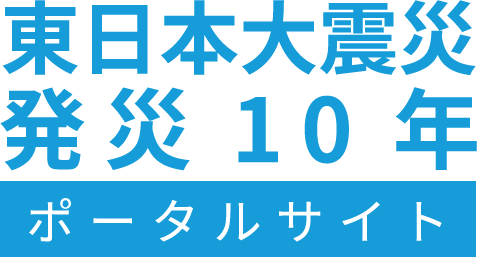
 文字サイズ
文字サイズ







